
MODEL
DIGITAL LASER COPIER/PRINTER
OPERATION MANUAL
Page

MODEL
DIGITAL LASER COPIER/PRINTER
OPERATION MANUAL
Page
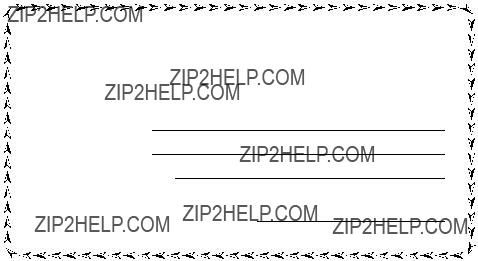
FOR YOUR RECORDS ...
To protect against loss theft, record and retain for reference the copier's serial number located on the back of the unit.
Model Number
Serial Number
Date of Purchase
Authorized Sharp Copier
Service Department Number
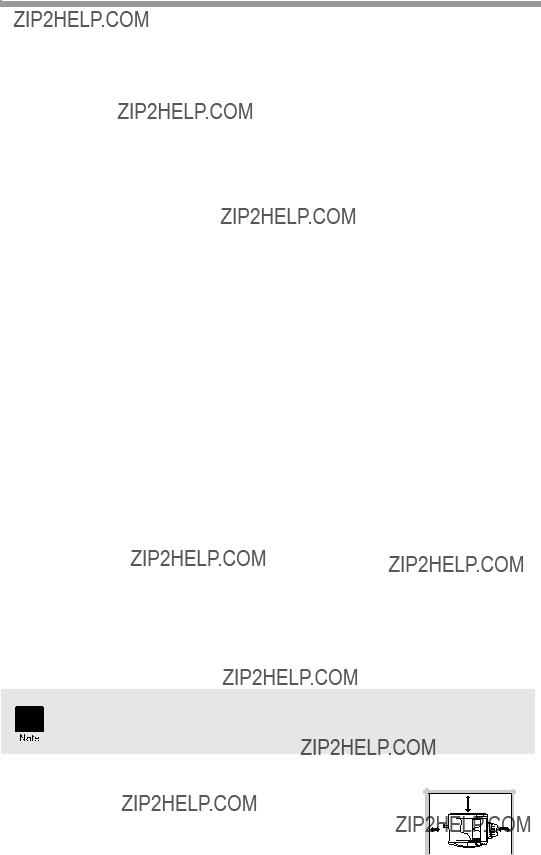
CAUTIONS
Caution label on the unit
The label (
 ) in the fusing area of the unit indicates the following:
) in the fusing area of the unit indicates the following:
 : Caution, risk of danger
: Caution, risk of danger  : Caution, hot surface
: Caution, hot surface
Cautions on using
Follow the cautions below when using this unit.
 Warning:
Warning:
???The fusing area is hot. Exercise care in this area when removing misfed paper.
???Do not look directly at the light source. Doing so may damage your eyes.
???Do not switch the unit rapidly on and off. After turning the unit off, wait 10 to 15 seconds before turning it back on.
???Unit power must be turned off before installing any supplies.
 Caution:
Caution:
???Place the unit on a firm, level surface.
???Do not install the unit in a humid or dusty location.
???When the unit is not used for a long time, for example for consecutive holidays, turn the power switch off and remove the power cord from the outlet.
???When moving the unit, be sure to turn the power switch off and remove the power cord from the outlet.
???Do not cover the unit with a dust cover, cloth or plastic film while the power is on. Doing so may prevent heat radiation, damaging the unit.
???Use of controls or adjustments or performance of procedures other than those specified herein may result in hazardous radiation exposure.
???The
Important points when selecting an installation site
Do not install your unit in areas that are:
???damp, humid, or very dusty
???exposed to direct sunlight
???poorly ventilated
???subject to extreme temperature or humidity changes, e.g., near an air conditioner or heater.
Be sure to connect the power cord only to a power outlet that meets the specified voltage and current requirements. Also make certain the outlet is properly grounded.
Connect the unit to a power outlet which is not used for other electric appliances. If a lighting fixture is connected to the same outlet, the light may flicker.
Be sure to allow the required space around the machine for servicing and proper ventilation.
1
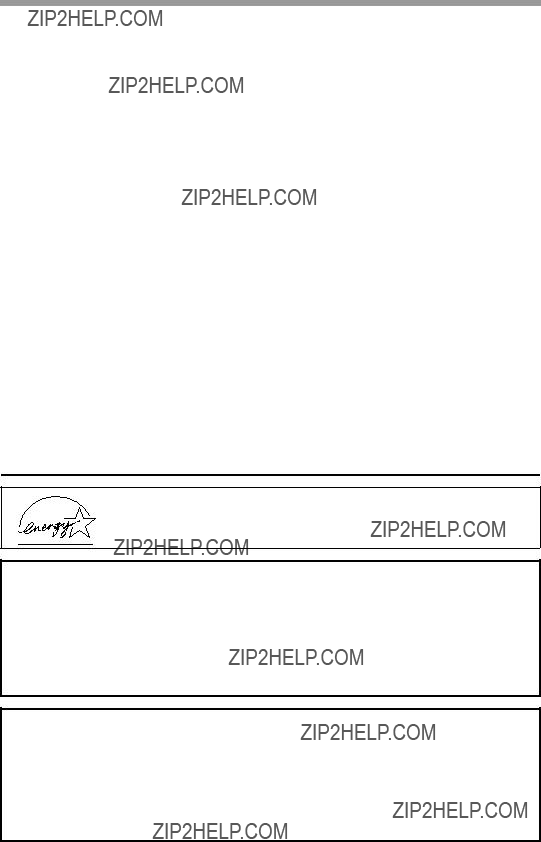
Cautions on handling
Be careful in handling the unit as follows to maintain the performance of this unit.
Do not drop the unit, subject it to shock or strike it against any object.
Store spare toner cartridges in a cool dry place without removing from the package before use.
??? If they are exposed to direct sunlight or excessive heat, poor copies may result.
Do not touch the photoconductive drum (green portion).
??? Scratches or smudges on the drum will cause dirty copies.
Proper storage for supplies
Store the supplies (paper and toner cartridges) in a location that is:
???clean and dry
???at a stable temperature
???not exposed to direct sunlight
Store paper in the wrapper and lying flat.
???Paper stored out of the wrapper or in packages standing on end may curl or get damp, resulting in paper misfeeds.
Trademark acknowledgements
???Microsoft and Windows are trademarks of Microsoft Corporation in the U.S.A. and other countries.
???IBM and PC/AT are trademarks of International Business Machines Corporation.
???Adobe and Acrobat are trademarks of Adobe Systems Incorporated.
???All other trademarks and copyrights are the property of their respective owners.
As an ENERGY STAR?? Partner, SHARP has determined that this product meets the ENERGY STAR?? guidelines for energy efficiency.
Safety precautions:
This Digital Copier is rated Class 1 and complies with 21 CFR 1040.10 and 1040.11 of the CDRH standards. This means that the unit does not produce hazardous laser radiation. For your safety, observe the precautions below.
???Do not remove the cabinet, operation panel or any other covers.
???The unit???s exterior covers contain several safety interlock switches. Do not bypass any safety interlock by inserting wedges or other items into switch slots.
A small amount of ozone is produced within the unit during operation. The emission level is insufficient to cause any health hazard.
Note:
The present recommended long term exposure limit for ozone is 0.1ppm (0.2mg/m3) calculated as an 8hr.
However, since the small amount that is emitted may have an objectionable odor, it is advisable to place the unit in a ventilated area.
2

CONTENTS
6 TROUBLESHOOTING THE UNIT
TROUBLESHOOTING THE UNIT
1
2
3
4
5
6
7
8
9
3

1 INTRODUCTION
This chapter provides basic information for using the unit.
USING THE MANUAL
The operation manual contains explanations of how to operate the unit, important considerations, and maintenance procedures. To get the most out of the unit, please read the operation manual. Please keep the operation manuals in a suitable location that will allow for convenient future reference.
Conventions used in the manual
This operation manual explains the operation of the
 :Standard functions and equipment
:Standard functions and equipment
 :Optional functions and equipment
:Optional functions and equipment
*1 Can be used when the optional Printer/Scanner Expansion Kit
*3 The optional
???This operation manual refers to the Reverse Single Pass Feeder as the "RSPF" and Single Pass Feeder as the "SPF".
???In this manual, the following icons are used to provide the user with information pertinent to the use of the unit.
Warns the user that injury may result if the contents of the warning are not properly followed.
Cautions the user that damage to the unit or one of its components may result if the contents of the caution are not properly followed.
Notes provide information relevant to the unit regarding specifications, functions, performance, operation and such, that may be useful to the user.
Indicates a letter displayed in the display.
4

PART NAMES
7Bypass paper guides
8Paper output tray
9Paper output tray extension
5
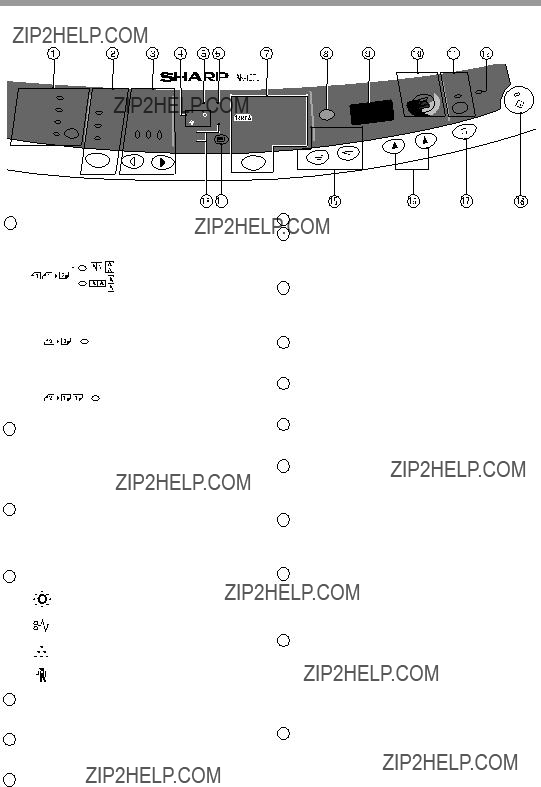
OPERATION PANEL
1Original to copy key and indicators
2Exposure mode selector key and indicators
Use to sequentially select the exposure modes: AUTO, MANUAL or PHOTO. Selected mode is shown by a lit indicator. (p.16)
3Light and dark keys and indicators
Use to adjust the MANUAL or PHOTO exposure level. Selected exposure level is shown by a lit indicator. (p.16) Use to start and terminate user program setting. (p.23)
4Alarm indicators
Developer replacement required indicator (p.37)
Misfeed indicator (p.32)
Toner cartridge replacement required indicator (p.25)
Maintenance indicator (p.37)
5RSPF/SPF indicator (p.15)
Can be used only when your unit has the RSPF/SPF.
6RSPF/SPF misfeed indicator (p.35)
Can be used only when your unit has the RSPF/SPF.
7Copy ratio selector key and indicators
Use to sequentially select preset reduction/enlargement copy ratios. Selected copy ratio is shown by a lit indicator. (p.18)
8Copy ratio display (%) key (p.18)
9Display
Displays the specified copy quantity, zoom copy ratio, user program code, and error code.
10SCANNER key and indicator (p.53, p.60)
Can be used when the Printer/Scanner Expansion Kit
11ONLINE key and indicator (p.53)
Can be used when the Printer/Scanner Expansion Kit
12Power save indicator
Lights up when the unit is in a power save mode. (p.22, p.23)
13Paper feed location indicators
Light up to show the selected paper feed station.
14Tray select key
Use to select a paper feed station (paper tray 1, paper tray 2 or
15ZOOM keys and indicator
Use to select any reduction or enlargement copy ratio from 25% to 400% in 1% increments. (p.18)
16Copy quantity keys
???Use to select the desired copy quantity (1 to 99). (p.16)
???Use to make user program entries. (p.23)
17Clear key
???Press to clear the display, or press during a copy run to terminate copying. (p.16)
???Press and hold down during standby to display the total number of copies made to date. (p.24)
18Start key and indicator
???Copying is possible when the indicator is on.
???Press to start copying.
???Use to set a user program. (p.23)
6

Follow the steps below to load paper into the tray.
PAPER
For best results, use only paper recommended by SHARP.
*Do not use
**For paper weighing from 28 lbs. to 34.5lbs,
can be fed through the
???Special papers such as transparency film, labels and envelopes must be fed one sheet at a time through the
7

LOADING THE PAPER TRAY
1 Raise the handle of the paper tray and pull the paper tray out until it stops.
2 Adjust the paper guides on the paper tray to the copy paper width and length. Squeeze the lever of paper guide A and slide the guide to match with the width of the paper. Move paper guide B to the appropriate slot as marked on the tray.
3 Fan the paper and insert it into the tray. Make sure the edges go under the corner hooks.
Do not load paper above the maximum height line ( 
 ). Exceeding the line will cause a paper misfeed.
). Exceeding the line will cause a paper misfeed.
8
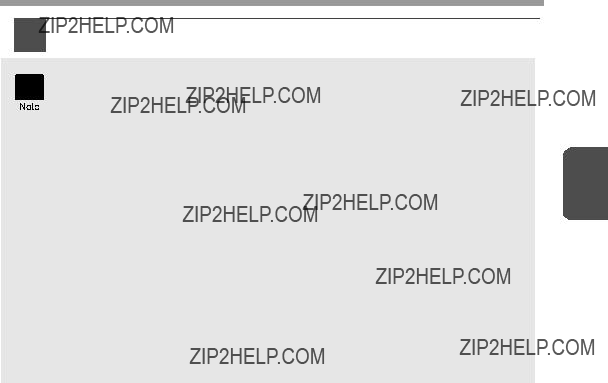
4 Gently push the paper tray back into the unit.
??? After loading paper, to cancel the blinking  without restarting copying, press the clear (
without restarting copying, press the clear ( ) key. The
) key. The  in the display will go out and the start (
in the display will go out and the start ( ) indicator will light up.
) indicator will light up.
???Be sure that paper is free of rips, dust, wrinkles, and curled or bent edges.
???Make sure all the paper in the stack is the same size and type.
paper to bend. Loading paper in these ways will result in document skew or a paper jam.
???When not using the unit for an extended period, remove all paper from the paper tray and store it in a dry place. If paper is left in the unit for an extended period, the paper will absorb moisture from the air, resulting in paper jams.
???When adding new paper to the paper tray, remove the old paper already contained in the tray. Placing new paper on top of the paper already contained in the tray may result in feeding two sheets at one time.
9

BYPASS FEED (including special paper)
The
(For paper weighing from 28 lbs. to 34.5 lbs.,
??? The
??? The original image must be smaller than the paper or media for copying. If the original image is bigger than the paper or media, this may cause smudges on the edges of the copies.
1 Open the
To close the multi- bypass tray, perform step 1 and then step 2 in the illustration and push the round projections at the right of the tray until they click.
2 Set the paper guides to the paper width. Insert the paper (print face down) all the way into the
Print face
10
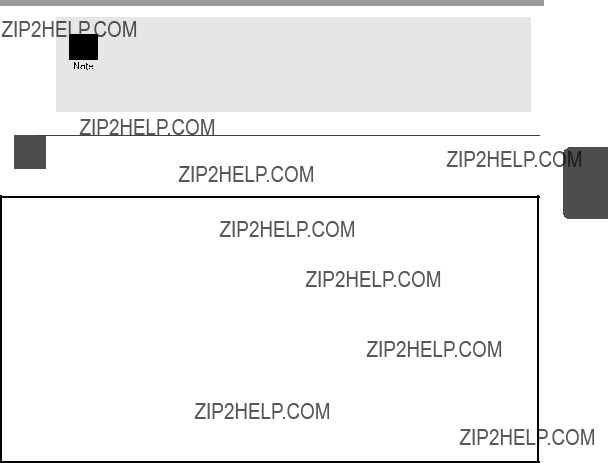
??? Paper must be fed narrow side into the feed slot.
??? Special papers such as transparency film and labels must be fed one sheet at a time through the
???When copying onto transparency film, remove each copy promptly. Do not let copies stack up.
3 Press the tray select ( ) key to select the
) key to select the
2
Note for loading envelopes
???Envelopes must be fed narrow side into the feed slot one at a time.
???Do not use
???Envelopes of which the surface is not flat because of embossing may cause the copies/prints to become smudged.
???Under high humidity and temperature conditions the glue flaps on some envelopes may become sticky and be sealed closed when copied/printed.
???Use only envelopes which are flat and crisply folded. Curled or poorly formed envelopes may be poorly copied/printed or may cause misfeeds.
???It is recommended that you perform a test copy before performing the actual copied/ printed job.
???Be sure to select either Com 10, DL, C5 or Monarch on the paper size setting of the printer driver. (For detailed information on printer driver, refer to the online manual.)
11
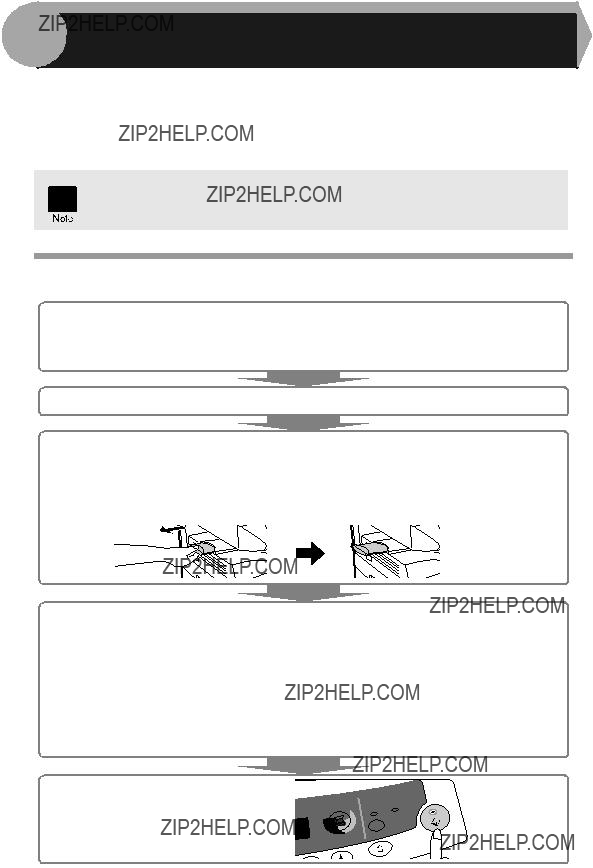
This chapter explains basic and other copying functions.
The unit is equipped with a
If the unit does not function properly during use, or if a function cannot be used, see "TROUBLESHOOTING THE UNIT" (p.30).
COPY FLOW
1Make sure that paper has been loaded in the paper tray (p.8) or
If paper is not loaded, see page 8.
2Turn on the unit (p.13).
3Place the original.
If you are using the original table, see "Using the original table" (p.14). If you are using the RSPF/SPF, see "Using the RSPF/SPF" (p.15). When copying onto paper larger than
4Select the copy settings.
If you wish to copy using the initial settings (p.13), proceed to the next step.
To set the number of copies, see page 16.
To adjust the resolution and contrast settings, see page 16. To enlarge or reduce the copy, see page 18.
To change the tray, see page 19.
To print on both sides of paper, see page 20.
5Start copying.
Press the start ( ) key.
) key.
12

POWER ON
Turn the power switch on the left side of the unit to the "ON" position. The start ( ) indicator will light up.
) indicator will light up.
About the scan head
The scan head lamp remains on constantly when the unit is in the ready condition (when the start (  ) indicator is illuminated).
) indicator is illuminated).
The unit adjusts the scan head lamp periodically to maintain copying quality. At this time, the scan head moves automatically. This is normal and does not indicate unit trouble.
Initial settings of operation panel
When the unit power is on, the operation panel will revert to the initial settings when the time set with the "Auto clear time" setting (p.22) elapses after a copy or scanner job is finished, or when the clear ( ) key is pressed twice.
) key is pressed twice.
The initial settings of the operation panel are shown below.
"0" is displayed in the display.
When copying is begun in this state, the settings in the following table are used.
13
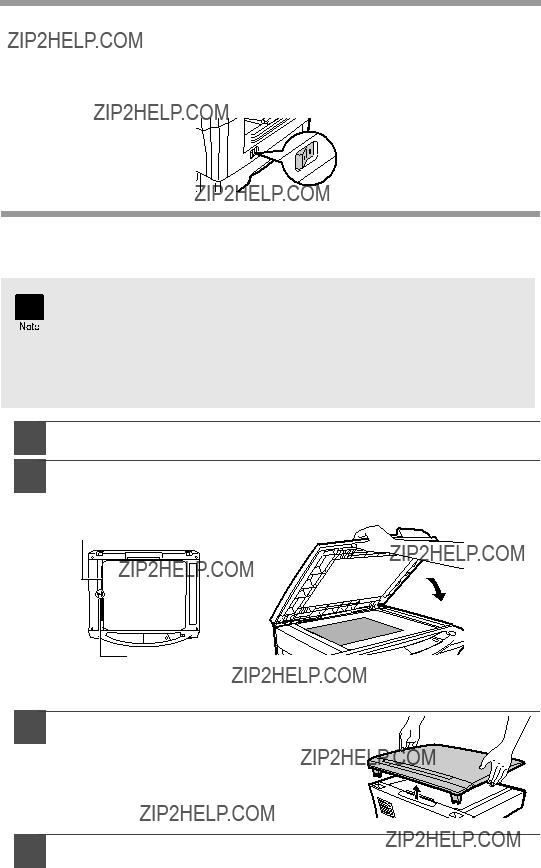
Power off methods
If not used for a certain period of time, the unit will automatically enter auto power
ORIGINAL PLACEMENT
Using the original table
??? The original table can read up to
??? Image loss 5/32" can occur at the leading and trailing edges of the copies. Also image loss 11/64" in total can occur along the other edges of the copies.
???When copying a book or an original which has been folded or a crumpled original, press down the original cover lightly. If the original cover is not securely closed, the copies may be striped or blurred.
1
2
Open the original cover/RSPF/SPF, and place the original.
Place an original face down on the original table. Align it with the original scale and the centering ( ) mark. Gently close the original cover/RSPF/SPF.
) mark. Gently close the original cover/RSPF/SPF.
Original scale
 mark
mark
Setting a large original
The original cover can be removed to allow copying of bulky objects.
1 Simply lift the original cover straight up.
2 To reattach the original cover, reverse the above procedure.
14

Using the RSPF/SPF
The RSPF/SPF is designed to hold up to 30 originals measuring from
1
2
3
Make sure that no original is left on the original table.
Adjust the original guides to the size of originals.
Stream feeding mode
The stream feeding mode allows easy operation of continuous copying from the RSPF/SPF. If the stream feeding mode has been enabled using user program No.4, the RSPF/SPF (  ) indicator will blink approximately 5 seconds after the last original has been fed by the RSPF/SPF. While this indicator is blinking, any new originals placed in the original feeder tray will be fed and copied automatically. If the stream feeding mode has been disabled, the start (
) indicator will blink approximately 5 seconds after the last original has been fed by the RSPF/SPF. While this indicator is blinking, any new originals placed in the original feeder tray will be fed and copied automatically. If the stream feeding mode has been disabled, the start ( ) key must be pressed each time the originals are set even immediately after completion of a copy run from the RSPF/SPF. The default setting of the stream feeding mode is "ON". See "USER PROGRAMS" (p.23).
) key must be pressed each time the originals are set even immediately after completion of a copy run from the RSPF/SPF. The default setting of the stream feeding mode is "ON". See "USER PROGRAMS" (p.23).
15

SET THE COPY QUANTITY
Set the number of copies using the two copy quantity ( ,
,  ) keys when copying from the original table or copying from RSPF/SPF.
) keys when copying from the original table or copying from RSPF/SPF.
??? Press the right copy quantity key to set the unit digit from 0 to 9. This key will not change the tens digit.
??? Press the left copy quantity key to set the tens digit from 1 to 9.
Tens digit Unit digit
EXPOSURE ADJUSTMENT/PHOTO COPYING
Exposure adjustment
Copy density adjustment is not required for most originals in the automatic exposure mode. To adjust the copy density manually or to copy photographs, the exposure level can be adjusted in five steps manually.
The copy resolution used for AUTO and MANUAL (  ) mode can be changed. (p.23)
) mode can be changed. (p.23)
1
2
Press the exposure mode selector key to select the MANUAL (  ) mode or PHOTO (
) mode or PHOTO (  ) mode.
) mode.
Use the light ( ) and dark (
) and dark ( ) keys to adjust the exposure level. If exposure level 2 is selected, the two
) keys to adjust the exposure level. If exposure level 2 is selected, the two
16

Automatic exposure adjustment
This automatic exposure level will remain in effect until you change it again by this procedure.
The automatic exposure level can be adjusted to suit your copying needs. This level is set for copying from the original table and copying from the RSPF/SPF respectively.
1
2
3
4
5
Press and hold down the exposure mode selector key for approximately 5 seconds. The PHOTO ( ) indicator will go out and the AUTO indicator will begin to blink. One or two light and dark indicators corresponding to the automatic exposure level which has been selected will light up.
) indicator will go out and the AUTO indicator will begin to blink. One or two light and dark indicators corresponding to the automatic exposure level which has been selected will light up.
Press the light ( ) or dark (
) or dark ( ) key to lighten or darken the automatic exposure level as desired. If exposure level 2 is selected, the two
) key to lighten or darken the automatic exposure level as desired. If exposure level 2 is selected, the two
Press the exposure selector key. The AUTO indicator will stop blinking and light up steadily.
17
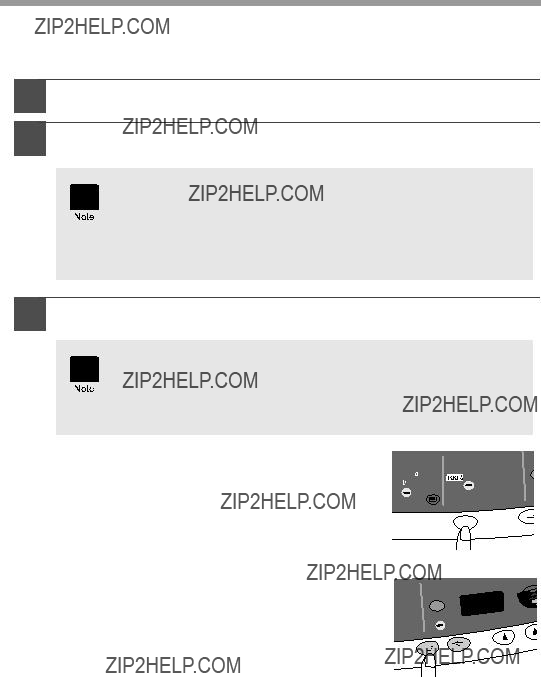
REDUCTION/ENLARGEMENT/ZOOM
Three preset reduction ratios and two enlargement ratios can be selected. The zoom function enables copy ratio selection from 25% to 400% in 1% increments.
1
2
Set the original and check the paper size.
Use the copy ratio selector key and/or ZOOM ( ,
,  ) keys to select the desired copy ratio.
) keys to select the desired copy ratio.
??? To verify a zoom setting without changing the zoom ratio, press and hold down the copy ratio display (%) key. When the key is released, the display will return to the copy quantity display.
???To reset the ratio to 100%, press the copy ratio selector key repeatedly until the 100% indicator lights up.
3 Set the reduction/enlargement ratio.
To decrease or increase the zoom ratio rapidly, press and hold down the ZOOM ( ) or (
) or ( ) key. However the value will stop at the preset reduction or enlargement ratios. To move beyond these ratios, release the key and then press and hold it down again.
) key. However the value will stop at the preset reduction or enlargement ratios. To move beyond these ratios, release the key and then press and hold it down again.
To select a preset copy ratio:
Preset reduction and enlargement ratios are: 25%, 64%, 78%, 129% and 400%.
To select a zoom ratio:
When a ZOOM ( or
or  ) key is pressed, the ZOOM indicator will light up and the zoom ratio will be displayed in the display.
) key is pressed, the ZOOM indicator will light up and the zoom ratio will be displayed in the display.
18

SELECTING THE TRAY
??? Paper sizes that can be used in the duplex copy mode are letter, legal, and invoice. When copying from the original table in the duplex copy mode, only letter size paper can be used.
??? The
Press the tray select ( ) key.
) key.
Each time you press the tray select ( ) key, the location indicated by the paper feed location indicator changes in the following order: paper tray 1, paper tray 2, multi- bypass tray.
) key, the location indicated by the paper feed location indicator changes in the following order: paper tray 1, paper tray 2, multi- bypass tray.
3
19

This chapter describes the special functions of this unit. Use these functions as needed.
ABOUT THE SPECIAL FUNCTIONS OF
Two sided copying
When copying from the RSPF,
??? When making
???When making
???When using
20

Making
1
2
Place the original(s) on the original table or in the RSPF. (see "ORIGINAL PLACEMENT" (p.14).
Select
A:When copying in a
Use the original to copy key to select the desired
B:When copying in the
Use the original to copy key to select the
C:When copying in the
Use the original to copy key to select the
4
A  B
B  C
C
3 Select the copy settings. See "SET THE COPY QUANTITY" (p.16), "EXPOSURE ADJUSTMENT/PHOTO COPYING" (p.16), and "REDUCTION/ENLARGEMENT/ZOOM" (p.18).
Using the original table
If you are using the original table, copying is only possible in one sided to
1Press the start ( ) key.
) key.
The original is scanned into the unit's memory and the number of the copy quantity blinks in the display.
2Place the original that you wish to copy onto the rear side of the paper, and press the start ( ) key again.
) key again.
Copying begins.
Using the RSPF
Press the start (  ) key. Copying begins in the selected
) key. Copying begins in the selected
21

DESCRIPTION OF SPECIAL FUNCTIONS
Toner save mode (page 22)
Reduces toner consumption by approximately 10%.
Power save modes (page 23)
The unit has two power save modes of operation: preheat mode and auto power
Preheat mode
When the unit enters the preheat mode, the power save (  ) indicator will light up and other indicators will remain on or off as before. In this condition, the fuser in the unit is maintained at a lower heat level, thereby saving power. To copy from the preheat mode, make desired copier selections and press the start (
) indicator will light up and other indicators will remain on or off as before. In this condition, the fuser in the unit is maintained at a lower heat level, thereby saving power. To copy from the preheat mode, make desired copier selections and press the start (  ) key using the normal copying procedure.
) key using the normal copying procedure.
Auto power
When the unit enters the auto power  ) indicator will light up and other indicators except the ONLINE indicator will go out. The auto power
) indicator will light up and other indicators except the ONLINE indicator will go out. The auto power  ) key. Then make desired copier selections and press the start (
) key. Then make desired copier selections and press the start (  ) key using the normal copying procedure.
) key using the normal copying procedure.
Auto clear (page 23)
The unit returns to the initial settings a preset amount of time after the end of copy, or scanner job. This preset amount of time (auto clear time) can be changed.
Stream feeding mode (page 23)
For description of the stream feeding mode, see "Stream feeding mode" (p.15).
Resolution of AUTO & MANUAL mode (page 23)
You can set the copy resolution used for AUTO and MANUAL (  ) exposure mode.
) exposure mode.
TONER SAVE MODE
1 Press the exposure mode selector key to select the MANUAL ( ) mode.
) mode.
22
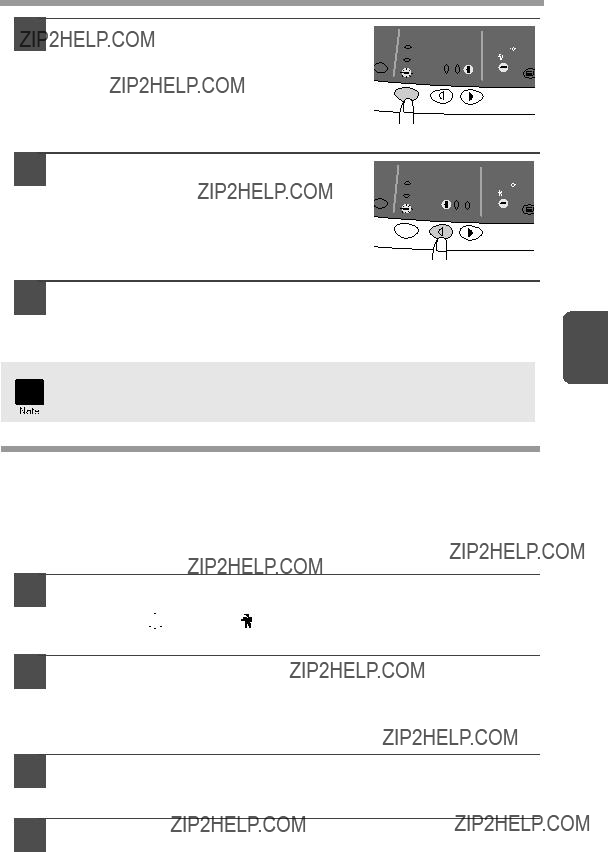
2
3
Press and hold down the exposure mode selector key for approximately 5 seconds. The MANUAL (  ) indicator will go out and the PHOTO (
) indicator will go out and the PHOTO ( ) indicator will begin to blink. The light and dark indicator marked "5" will light up, indicating the standard toner mode is active.
) indicator will begin to blink. The light and dark indicator marked "5" will light up, indicating the standard toner mode is active.
To enter the toner save mode, press the light ( ) key. The light and dark indicator marked "1" will light up, indicating the toner save mode is selected.
) key. The light and dark indicator marked "1" will light up, indicating the toner save mode is selected.
4 Press the exposure mode selector key. The PHOTO ( )
)
To return to the standard mode, repeat the procedure but use the dark ( ) key to select exposure level "5" in step 3.
) key to select exposure level "5" in step 3.
USER PROGRAMS
The user programs allow the parameters of certain functions to be set, changed, or cancelled as desired.
Setting the power save modes, auto clear time, stream feeding mode and resolution of AUTO & MANUAL mode
1
2
3
4
Press and hold down the light ( ) and dark (
) and dark ( ) keys simultaneously for more than 5 seconds until all the alarm indicators (
) keys simultaneously for more than 5 seconds until all the alarm indicators (
 ,
,  ,
,  , ) blink and "
, ) blink and " " appears in the display.
" appears in the display.
Use the left copy quantity ( ) key to select a user program number (1: auto clear time, 2: preheat mode, 3: auto power
) key to select a user program number (1: auto clear time, 2: preheat mode, 3: auto power
Press the start ( ) key. The entered program number will be steadily lit and the currently selected parameter number for the program will blink on the right side of the display.
) key. The entered program number will be steadily lit and the currently selected parameter number for the program will blink on the right side of the display.
Select the desired parameter using the right copy quantity ( ) key. The entered parameter number will blink on the right of the display.
) key. The entered parameter number will blink on the right of the display.
23

Resolution of AUTO
6*0 300dpi, 1 600dpi & MANUAL mode
* Factory default settings are indicated with an asterisk (*).
Program No. 4 can be used when your unit has the RSPF/SPF.
5 Press the start ( ) key. The
) key. The
To change the setting or to set another mode, press the clear ( ) key. The unit will return to step 2.
) key. The unit will return to step 2.
6 Press the light ( ) or dark (
) or dark ( ) key to return to the normal copy mode.
) key to return to the normal copy mode.
DISPLAYING TOTAL NUMBER OF COPIES
Use the following procedure to display the total number of copies.
1
2
Press the clear ( ) key to reset the display to zero.
) key to reset the display to zero.
Press and hold down the clear ( ) key for approximately 5 seconds. The total number of copies will appear in two steps, each with three digits.
) key for approximately 5 seconds. The total number of copies will appear in two steps, each with three digits.
Example: Total number of copies is 1,234.
24
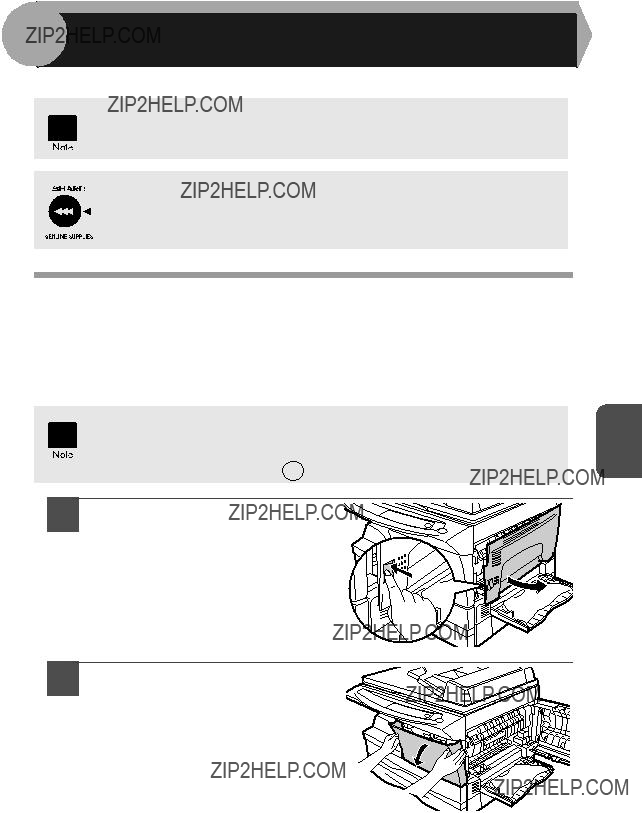
5 MAINTENANCE
This chapter describes how to replace the toner cartridge and how to clean the unit.
Be sure to use only genuine SHARP parts and supplies.
For best copying results, be sure to use only SHARP Genuine Supplies which are designed, engineered, and tested to maximize the life and performance of SHARP copiers. Look for the Genuine Supplies label on the toner package.
TONER CARTRIDGE REPLACEMENT
When the toner cartridge replacement required ( ) indicator lights up, replacement of the toner cartridge will be needed soon. Obtain a new cartridge. When the toner cartridge replacement required (
) indicator lights up, replacement of the toner cartridge will be needed soon. Obtain a new cartridge. When the toner cartridge replacement required ( ) indicator blinks, the toner cartridge must be replaced before copying can be resumed. Replace the toner cartridge by following the procedure below.
) indicator blinks, the toner cartridge must be replaced before copying can be resumed. Replace the toner cartridge by following the procedure below.
During long copy run of a dark original, the start ( ) indicator may
) indicator may
blink, the indicator light up, and the unit stop, even though toner is left. 5 The unit will feed toner up to 2 minutes and then the start ( ) indicator
) indicator
will light up. Press the start (  ) key to restart copying.
) key to restart copying.
1
2
Open the
Push gently on both sides of the front cover to open the cover.
25
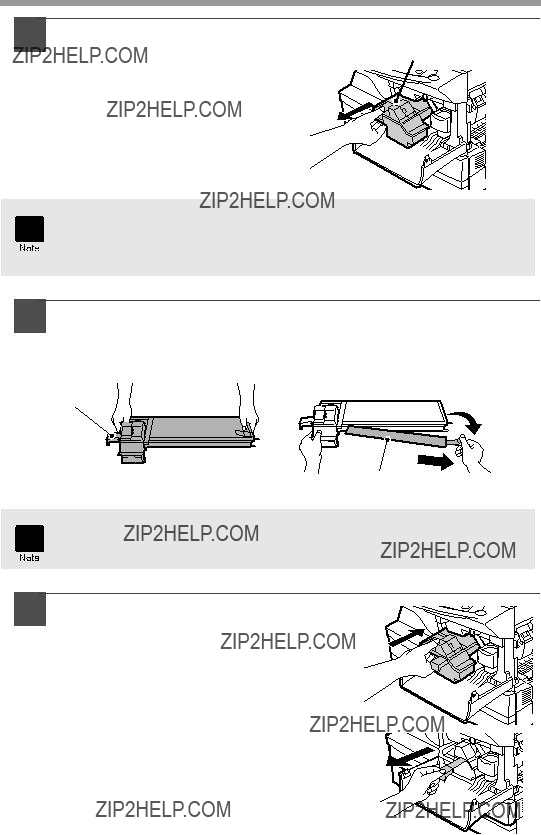
??? After removing the toner cartridge, do not shake it or tap on it. Doing so may cause toner to leak from the cartridge. Put the old cartridge immediately in the bag contained in the box of the new cartridge.
??? Dispose of the old toner cartridge in accordance with local regulations.
4 Remove the toner cartridge from the bag. Grasp the cartridge on both sides and shake it horizontally four or five times. After shaking the cartridge, remove the toner seal.
4 or 5 times Shutter 





Toner seal
Grasp the toner cartridge as shown in the illustration. Do not hold the cartridge by the shutter. Be sure to only shake the cartridge before the toner seal is removed.
5 Gently insert the toner cartridge along the guides until it locks in place while pushing the lock release lever.
Remove the tape from the shutter. Pull the shutter out of the toner cartridge as shown in the illustration. Discard the shutter.
26

6 Close the front cover and then the side cover by pressing the round projections near the side cover open button. The indicator will go out and the start ( ) indicator will light up.
) indicator will light up.
When closing the covers, be sure to close the front cover securely and then close the side cover. If the covers are closed in the wrong order, the covers may be damaged.
Even after a new toner cartridge is installed, the start ( ) indicator may not light up, indicating copying cannot be restarted (toner is not sufficiently fed). In this case, open and close the side cover. The
) indicator may not light up, indicating copying cannot be restarted (toner is not sufficiently fed). In this case, open and close the side cover. The
copier will feed toner again approximately 2 minutes and then5 copying can be restarted.
27

CLEANING THE UNIT
Proper care is essential in order to get clean, sharp copies. Be sure to take a few minutes to regularly clean the unit.
??? Before cleaning, be sure to turn the power switch off and remove the power cord from the outlet.
??? Do not use thinner, benzene or other volatile cleaning agents. Doing so may cause deformation, discoloration, deterioration or malfunction.
Cabinet
Wipe the cabinet with a soft, clean cloth.
Original table and the back side of the original cover/RSPF/
SPF
Stains on the glass, RSPF/SPF scanning window, cover or RSPF/SPF roller will also be copied. Wipe the glass, RSPF/SPF scanning window, cover and RSPF/SPF roller with a soft, clean cloth. If necessary, dampen the cloth with a glass cleaner.
RSPF/SPF roller
RSPF/SPF scanning window
28
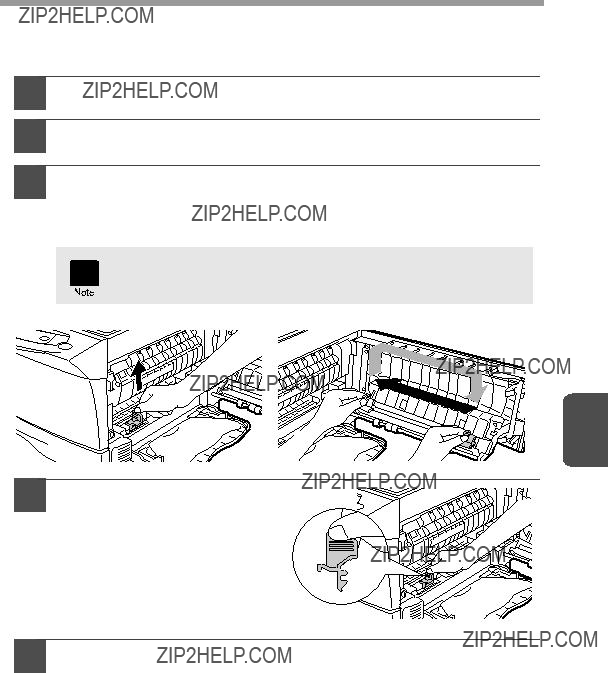
Transfer charger
If copies start becoming streaky or blotchy, the transfer charger may be dirty. Clean the charger using the following procedure.
1
2
3
Turn the power switch off. (p.14)
Ensure that the
Take the charger cleaner out by holding the tab. Set the charger cleaner onto the right end of the transfer charger, gently slide the cleaner to the left end, and then remove it. Repeat this operation two or three times.
Slide the charger cleaner from the right end to the left end along the groove of the transfer charger. If the cleaner is stopped on the way, smudges on copies may occur.
5
29

6 TROUBLESHOOTING THE UNIT
This chapter describes misfeed removal and troubleshooting.
TROUBLESHOOTING
If any problem occurs, check the list below before contacting the SHARP service center.
30

STATUS INDICATORS
When the following indicators light up or blink on the operation panel or the following alphanumeric codes appear in the display, solve the problem immediately referring to both the table below and the relevant page.
Be sure to use only genuine SHARP parts and supplies.
31
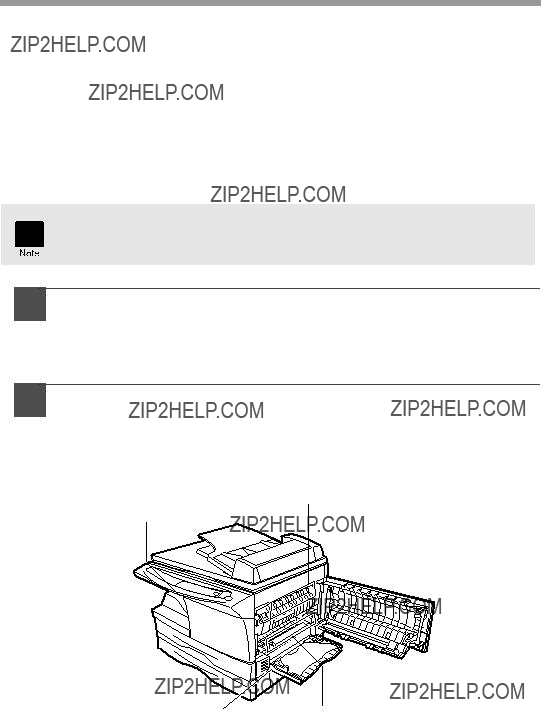
MISFEED REMOVAL
When the misfeed ( ) indicator blinks or
) indicator blinks or  blinks in the display, the unit will stop because of a misfeed. If a misfeed occurs when using the RSPF/SPF, a number may appear in the display after a minus sign. This indicates the number of the originals that must be returned to the original feeder tray after a misfeed. Return the required number of originals. Then this number will disappear when copying is resumed or the clear (
blinks in the display, the unit will stop because of a misfeed. If a misfeed occurs when using the RSPF/SPF, a number may appear in the display after a minus sign. This indicates the number of the originals that must be returned to the original feeder tray after a misfeed. Return the required number of originals. Then this number will disappear when copying is resumed or the clear ( ) key is pressed. When the RSPF/SPF misfeeds an original sheet, the unit will stop and the RSPF/SPF misfeed (
) key is pressed. When the RSPF/SPF misfeeds an original sheet, the unit will stop and the RSPF/SPF misfeed (  ) indicator will blink, while the misfeed (
) indicator will blink, while the misfeed ( ) indicator will remain off. For a misfeed of originals in the RSPF/SPF, see "E: Misfeed in the RSPF/SPF" (p.35).
) indicator will remain off. For a misfeed of originals in the RSPF/SPF, see "E: Misfeed in the RSPF/SPF" (p.35).
If the unit is turned on with the lower side cover open, the misfeed ( ) indicator will blink. In this case, close the lower side cover. The misfeed (
) indicator will blink. In this case, close the lower side cover. The misfeed ( ) indicator will go out.
) indicator will go out.
1 Open the
To open the
2 Check the misfeed location. Remove the misfed paper following the instructions for each location in the illustration below. If the misfeed ( ) indicator blinks, proceed to "A: Misfeed in the paper feed area" (p.33).
) indicator blinks, proceed to "A: Misfeed in the paper feed area" (p.33).
If the misfed paper is seen from this side, proceed to "C: Misfeed in the transport area". (p.34)
If paper is misfed here, proceed to "B: Misfeed in the fusing area". (p.33)
If paper is misfed here, proceed to "D: Misfeed in the lower
paper feed area". (p.35)
If paper is misfed here, proceed to "A: Misfeed in the paper feed area". (p.33)
32

A:Misfeed in the paper feed area
1Gently remove the misfed paper from the paper feed area as shown in the illustration. When the misfeed ( ) indicator blinks and the misfed paper is not seen from the paper feed area, pull out the paper tray and remove the misfed paper. If the paper cannot be removed, proceed to "B: Misfeed in the fusing area".
) indicator blinks and the misfed paper is not seen from the paper feed area, pull out the paper tray and remove the misfed paper. If the paper cannot be removed, proceed to "B: Misfeed in the fusing area".
The fusing unit is hot. Do not touch the fusing unit when removing misfed paper. Doing so may cause a burn or other injury.
??? Do not touch the photoconductive drum (green portion) when removing the misfed paper. Doing so may cause smudges on copies.
???If the paper has been fed through the
33
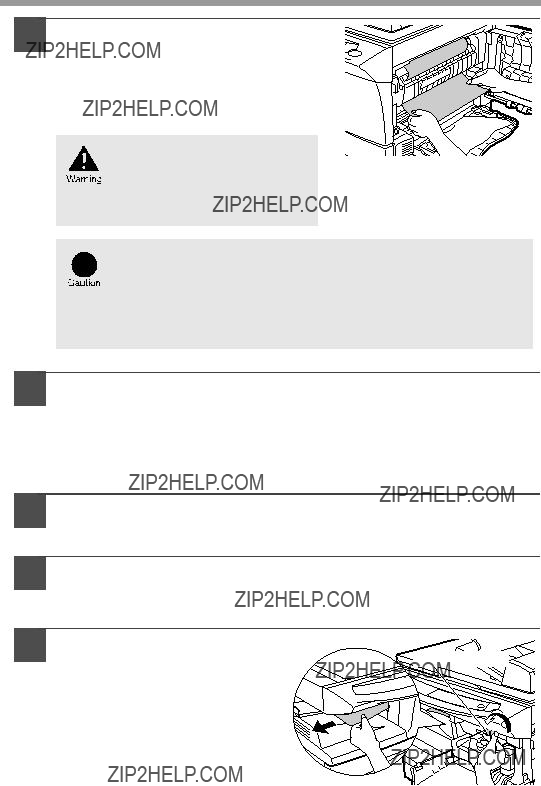
2 Gently remove the misfed paper from under the fusing unit as shown in the illustration. If the paper cannot be removed, proceed to "C: Misfeed in the transport area".
The fusing unit is hot. Do not touch the fusing unit when removing misfed paper. Doing so may cause a burn or other injury.
??? Do not touch the photoconductive drum (green portion) when removing the misfed paper. Doing so may cause smudges on copies.
???Do not remove the misfed paper from above the fusing unit. Unfixed toner on the paper may stain the paper transport area, resulting in smudges on copies.
3 Raise the fusing unit release lever and then close the side cover by pressing the round projections near the side cover open button. The misfeed ( ) indicator will go out and the start (
) indicator will go out and the start ( ) indicator will light up.
) indicator will light up.
C:Misfeed in the transport area
1Lower the fusing unit release lever.
See "B: Misfeed in the fusing area" (p.33).
2Open the front cover.
To open the front cover, see "TONER CARTRIDGE REPLACEMENT" (p.25).
34
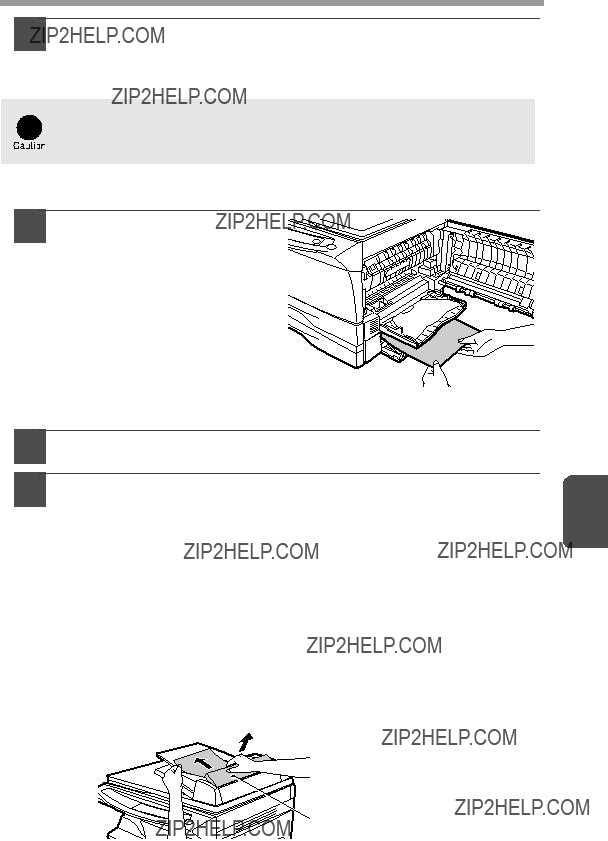
4 Raise the fusing unit release lever, close the front cover and then close the side cover by pressing the round projections near the side cover open button. The misfeed ( ) indicator will go out and the start (
) indicator will go out and the start ( ) indicator will light up.
) indicator will light up.
When closing the covers, be sure to close the front cover securely and then close the side cover. If the covers are closed in the wrong order, the covers may be damaged.
D: Misfeed in the lower paper feed area
1 Open the lower side cover (under the  ) indicator blinks and the misfed paper is not seen from the area of the lower side cover, pull out the lower paper tray and remove the misfed paper. Then close the lower paper tray.
) indicator blinks and the misfed paper is not seen from the area of the lower side cover, pull out the lower paper tray and remove the misfed paper. Then close the lower paper tray.
2
3
Close the lower side cover.
Close the side cover by pressing the round projections near
the side cover open button. The misfeed ( ) indicator will go 6 out and the start (
) indicator will go 6 out and the start ( ) indicator will light up.
) indicator will light up.
E: Misfeed in the RSPF/SPF
An original misfeed may occur at one of three locations: if the misfed original is seen from the original feeder tray, (A) in the original feeder tray; if the misfed original is not seen from the original feeder tray, (B) in the exit area or (C) under the feeding roller. Remove the misfed original following the instructions for each location.
(A)Open the feeding roller cover and pull the original gently to the left and out from the original feeder tray. Close the feeding roller cover. Open and close the RSPF/SPF to clear the RSPF/SPF misfeed (  ) indicator. If the misfed original cannot be easily removed, proceed to (C).
) indicator. If the misfed original cannot be easily removed, proceed to (C).
Feeding roller cover
35
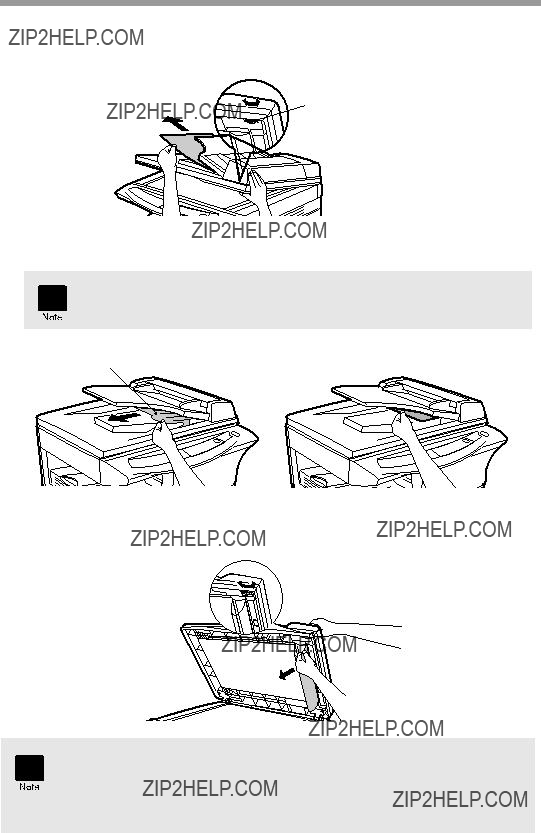
(B)Open the RSPF/SPF and rotate the roller rotating knob to remove the misfed original from the exit area. If the misfed original cannot be easily removed, proceed to (C).
Roller rotating knob
With the RSPF, pull out the reversing tray to remove the misfed original.
With the RSPF, after removing the misfed original from the exit area, be sure to insert the reversing tray into the exit area until it locks in place.
Reversing tray
(C)If the original does not move easily into the exit area, remove it in the direction of the arrow while rotating the knob.
A number may appear in the display after a minus sign, indicating the number of the originals that must be returned to the original feeder tray. Open and close the RSPF/SPF to clear the RSPF/SPF misfeed (  ) indicator, and then return the required number of originals. Then press the start (
) indicator, and then return the required number of originals. Then press the start ( ) key to resume copying.
) key to resume copying.
36
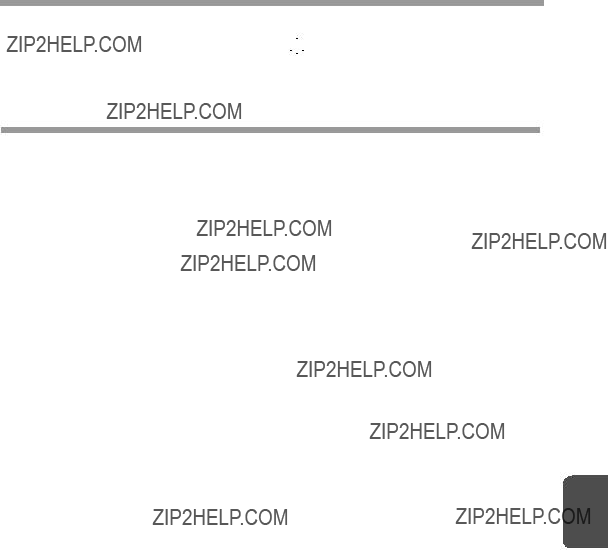
DEVELOPER REQUIRED
When the developer replacement required (
 ) indicator lights up, the developer should be replaced. DEVELOPER REPLACEMENT SHOULD ONLY BE DONE BY AN AUTORIZED SHARP SERVICE TECHNICIAN. Contact your service center as soon as possible.
) indicator lights up, the developer should be replaced. DEVELOPER REPLACEMENT SHOULD ONLY BE DONE BY AN AUTORIZED SHARP SERVICE TECHNICIAN. Contact your service center as soon as possible.
MAINTENANCE REQUIRED
When maintenance (  ) indicator lights up, service by an authorized SHARP service technician is required. Contact your service center as soon as possible.
) indicator lights up, service by an authorized SHARP service technician is required. Contact your service center as soon as possible.
6
37

SYSTEM CONFIGURATION
A number of options are available for the unit which allow you to configure a system to meet your particular needs. The options include the following.
Printer/Scanner
Expansion Kit
PRINTER/SCANNER EXPANSION KIT
A printer function and scanner function can be added to the unit by installing the AR- PG2. For information on installing the software for these functions, see "INSTALLING THE SOFTWARE" (p.40).
SINGLE PASS FEEDER
The single pass feeder (SPF) holds up to 30 originals for automatic feeding.
The procedures for placing originals in the SPF, cleaning the SPF, and removing a misfeed are the same as for the RSPF. See "Using the RSPF/ SPF" (p.15), "CLEANING THE UNIT" (p.28) and "E: Misfeed in the RSPF/ SPF" (p.35).
Original guide
Original exit area
38
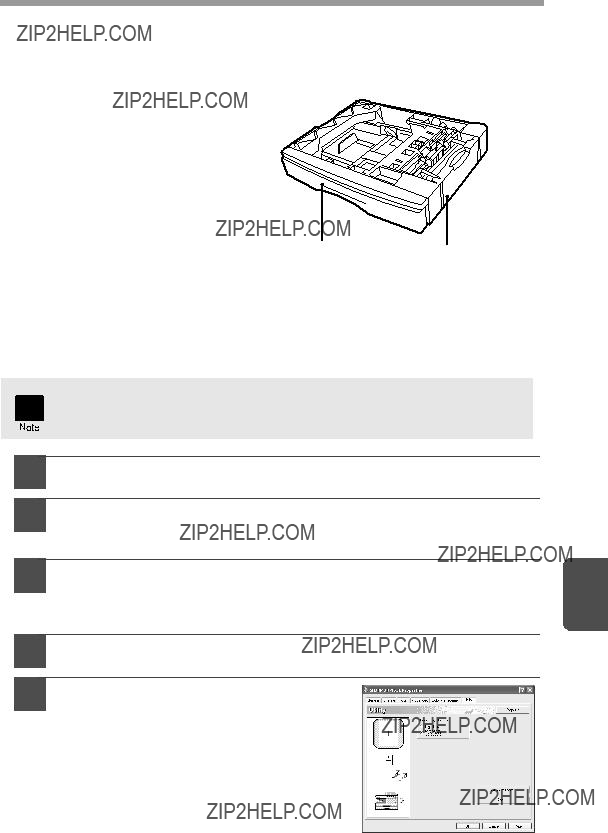
The paper feed unit provide the convenience of increased paper capacity for the unit and a greater choice of paper size readily available for copying.
The procedures for loading paper in the paper tray of paper feed unit, changing the paper size, and selecting the paper tray are same as for the paper tray in the unit. See "LOADING THE PAPER TRAY" (p.8) and "SELECTING THE TRAY" (p.19).
Using the paper feed unit with the printer function (when the
When the printer/scanner expansion kit is installed on the unit, the
The printer driver cannot be set for use with the
1
2
3
4
5
select "Properties" from the "File" menu, and then click the "Setup" tab.
Click the "Utility" tab.
Select "Two trays" for "Input tray option", and click "OK".
The printer driver closes. This completes the settings needed to use the
39
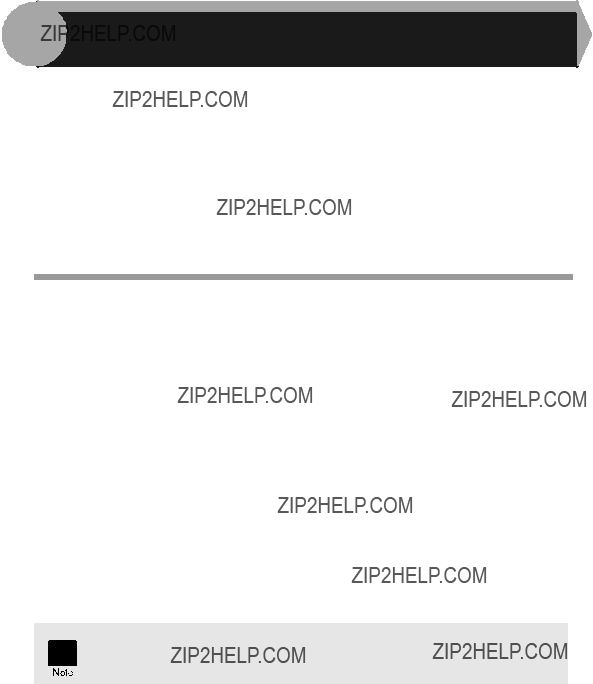
8 INSTALLING THE SOFTWARE
The procedure for installing the software for the optional
Illustrations of driver screens and other computer screens show the screens that appear in Windows XP Home Edition. Some of the names that appear in these illustrations may differ slightly from the screens that appear in other operating systems.
The following term is used in this chapter.
Means the supplied
SOFTWARE FOR THE SHARP PERSONAL MFP
SERIES
The supplied
MFP driver
Scanner driver
Permits you to operate scanning function of this unit with
Printer driver
Enables you to use the printer function of this unit with your computer.
Print Status Window
The print state and information on current printing are displayed on the status monitor window.
Sharpdesk
An integrated software environment that makes it easy to manage document and image files and launch applications.
Button Manager
Button Manager enabling the SCANNER ( ) key located on the unit.
) key located on the unit.
The scanning feature is only available with Windows 98/Me/2000/XP using a USB connection. For users running Windows 95/NT 4.0 or using a parallel connection, only printing is available.
40
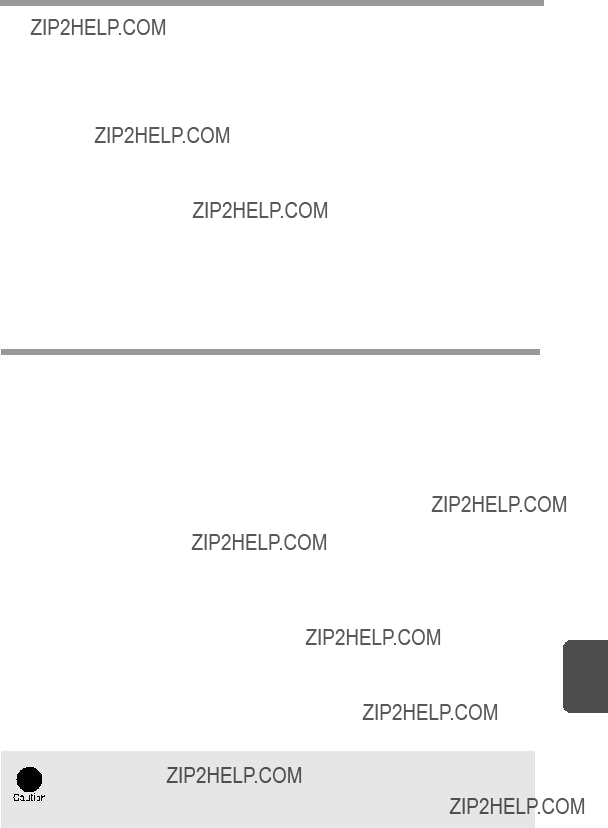
HARDWARE AND SOFTWARE REQUIREMENTS
Check the following hardware and software requirements in order to install the software.
*1 Compatible with Windows 98, Windows Me, Windows 2000 Professional, Windows XP Professional or Windows XP Home Edition preinstalled model with USB interface equipped as standard.
*2 Printing is unavailable in
*3 The administrator's authorization is required to install this software using this installer.
BEFORE INSTALLATION
The following table shows the drivers and software that can be installed for each version of Windows and interface connection method.
to your computer manual or ask the manufacturer of your computer.
*2 Sharpdesk can be installed when using a parallel interface connection, however, the unit???s scanner function cannot be used.
Is there another GDI printer driver or a Windows Printing System printer driver already installed? If installed, change the printer port setting. For the change of the printer port setting, see "USING OTHER INSTALLED DRIVERS" (p.66).
41

Flow of installation
Refer to the following table and then begin installation.
42

INSTALLING THE SOFTWARE
The following term is used in this section.
MFP
Means the unit as a printer and scanner.
??? For this description, it is assumed that the mouse is configured for right hand operation.
??? To print or scan, the MFP must be in the online state.
???The scanner feature only works when using a USB interface cable.
???If any error message appears, solve the problem following the instructions on the screen. After your problem is solved, the installing procedure will be continued. Depending on your problem, you may have to exit the installer. In this case, click the "Cancel" button to exit the installer. After solving your problem, reinstall the software from the beginning.
Installing onto Windows XP (USB/parallel interface)
Before starting the installation, make sure the USB or parallel interface cable is not connected to the MFP.
1
2
Insert the supplied
Click the "start" button, click "My Computer" (  ), and then
), and then  ) icon.
) icon.
When any of "Found New Hardware Wizard" messages appear during the software installation, be sure to click the "Cancel" button.
Click the "Display README" button to show the information on the selected package.
43

??? If you are using the parallel interface connection, do not select the Button Manager checkbox because this feature is not supported with the parallel interface.
???If the following screen appears, click the "OK" button. Review the contents in "BEFORE INSTALLATION" (p.41), and then select only appropriate the software packages to be installed.
5 Review the software packages to be installed on the screen, and then click the "Start" button.
The software packages to be installed will be displayed on the screen. If inappropriate packages are displayed, click the "Back" button to select appropriate packages again.
6 Copying files for MFP driver installation (This step will start if it was selected in step 4).
1After confirming the message in the "Welcome" window, click the "Next" button.
2A dialog box appears asking you to verify that the USB or parallel interface cable is not connected to the MFP. Make sure that the interface cable is not connected and click the "Next" button.
3Click the "Next" button in the dialog box to install the MFP driver or Cancel to quit the installation.
The setup program will start to copy the files.
If the following screen appears while the files are being copied (the message may appear more than once), click "Continue Anyway".
4When the "The MFP driver installation is complete." dialog box appears, click the "OK" button.
The Button Manager installer will start.
44
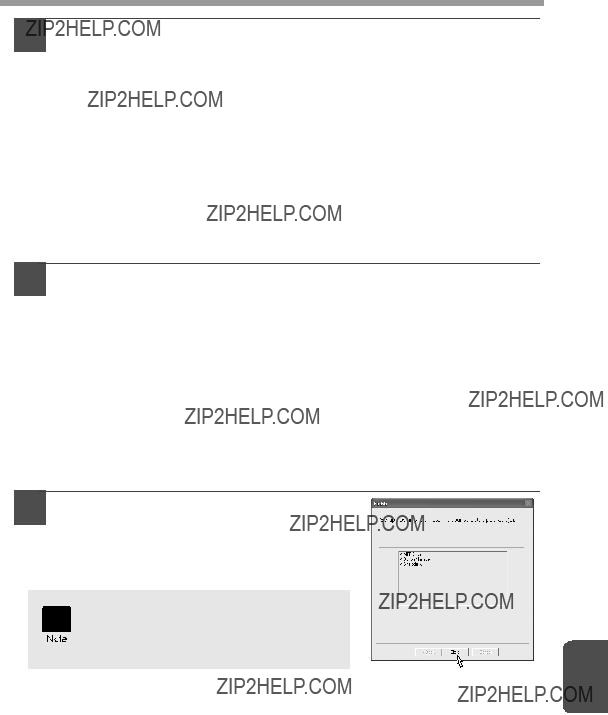
7
8
Begin installation of the Button Manager (This step will start if it was selected in step 4).
1After confirming the message in the "Welcome" window, click the "Next" button.
2Read the message in the "Please read the following information." window, and then click the "Next" button.
3When a message appears that lets you specify the location for the software to be installed, click the "Next" button.
4If the program displays "Do you want the Button Manager added to Windows Startup?", check "Yes" and click the "OK" button.
The setup program will start to copy the files.
5Click the "Finish" button when the message informs you that setup is successful.
The Sharpdesk installer will start.
Begin installation of the Sharpdesk (This step will start if it was selected in step 4).
1After confirming the message in the "Welcome to Sharpdesk installation" window, click the "Next" button.
2Read the message in the "Information" window, and then click the "Next" button.
3When the "Choose Destination Location" window appears, click the "Next" button.
4When the "Select Program Folder" window appears, click the "Next" button.
The setup program will start to copy the files.
5Click the "Finish" button when the message informs you that Setup is complete.
9 Click the "Close" button when the message informs you that "Setup has finished". When the "Now connect the MFP interface cable to the PC" dialog box appears, click the "OK" button.
After the installation, a message to restart your computer may be displayed. In this case, click the "Yes" button to restart your computer.
8
45

10 Connect the USB interface cable or parallel interface cable. (p.67)
Windows will detect the MFP and the Plug and Play screen will appear. If you are using Windows XP with the parallel interface, go to step 12.
11 Begin installation of the scanner driver.
1"SHARP
2The "Install hardware" dialog box will appear. Click the "Continue Anyway" button.
3When installation of the driver is completed, click the "Finish" button to finish the scanner driver installation.
12 Begin installation of the printer driver.
1"SHARP
2The "Hardware Installation" dialog box will appear. Click the "Continue Anyway" button.
3When installation of the driver is completed, click the "Finish" button to finish the printer driver installation.
You have completed the installation of all the software.
46
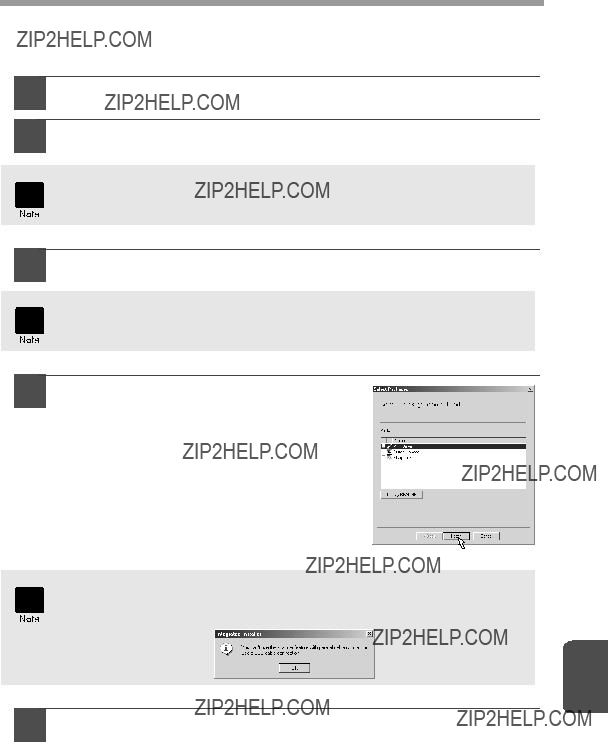
Installing onto Windows 98/Me/2000 (USB interface)
Before starting the installation, make sure the USB interface cable is not connected to the MFP.
1
2
Insert the supplied
 ), and then
), and then  ) icon.
) icon.
When any of "Hardware Found", or "Found New Hardware Wizard" messages appear during the software installation, be sure to click the "Cancel" button.
3  ) icon.
) icon.
If the language selection screen appears after you double click the "setup" icon, select the language you wish to use and click the "Next" button. (Normally, the correct language is selected automatically.)
4
5
Select the software packages to be installed, and then click the "Next" button.
The software packages with checkmark (  ) on the list on the screen will be installed. Click the "Display README" button to show the information on the selected package.
) on the list on the screen will be installed. Click the "Display README" button to show the information on the selected package.
If the following screen appears, click the "OK" button. Review the contents in "BEFORE INSTALLATION" (p.41), and then select the appropriate driver software packages to be installed.
8
Review the software packages to be installed on the screen, and then click the "Start" button.
The software packages to be installed will be displayed on the screen. If inappropriate packages are displayed, click the "Back" button to select appropriate packages again.
47
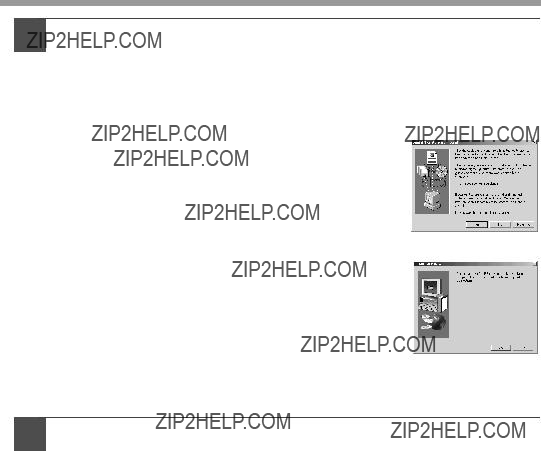
6
7
Copying files for MFP driver installation.
1After confirming the message in the "Welcome" window, click the "Next" button.
2A dialog box appears asking you to verify that the interface cable is not connected to the MFP. Make sure that the interface cable is not connected and click the "Next" button.
3Click the "Next" button in the dialog box showing the files to be copied for installation of the MFP driver.
The setup program will start to copy the files.
In Windows 2000, if the following screen appears while the files are being copied (the message may appear more than once), click "Yes" in Windows 2000.
4The following screen appears when all of the files for the USB interface connection have been copied. If you are not using a parallel interface cable for connection to the MFP, please click the "No" button.
5When the "The MFP driver installation is complete." dialog box appears, click the "OK" button.
The Button Manager installer will start.
Begin installation of the Button Manager (This step will start if it was selected in step 4).
1After confirming the message in the "Welcome" window, click the "Next" button.
2Read the message in the "Please read the following information." window, and then click the "Next" button.
3When a message appears that lets you specify the location for the software to be installed, click the "Next" button.
4If the program displays "Do you want to add Button Manager to Startup program?", check "Yes" and click the "OK" button.
The setup program will start to copy the files.
5Click the "Finish" button when the message to inform you of the completion of the installation appears.
The Sharpdesk installer will start.
48

8 Begin installation of the Sharpdesk (This step will start if it was selected in step 4).
1After confirming the message in the "Welcome to Sharpdesk installation" window, click the "Next" button.
2Read the message in the "Information" window, and then click the "Next" button.
3When the "Choose Destination Location" window appears, click the "Next" button.
4When the "Select Program Folder" window appears, click the "Next" button.
The setup program will start to copy the files.
If the dialog box asking "If you have TIF files saved using Photoshop or Imaging for Windows you should hit Skip" appears, answer the question to continue the Sharpdesk installation.
49
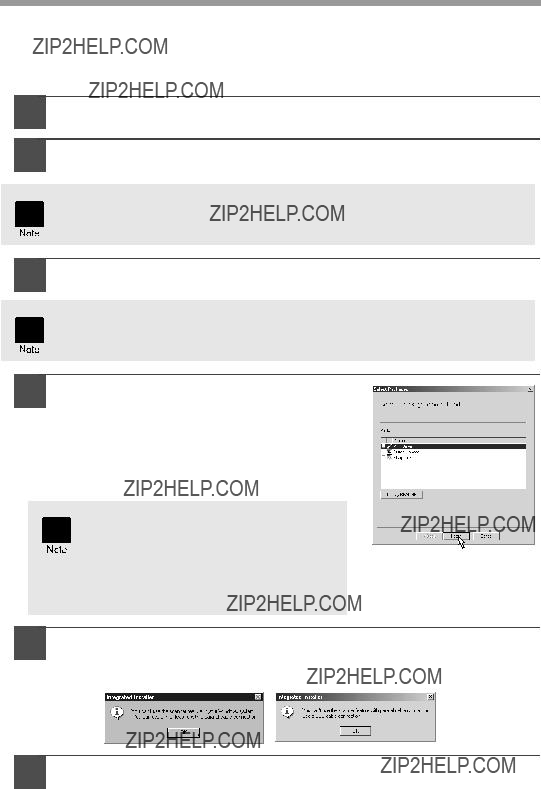
Installing onto Windows 95/98/Me/NT4.0/2000 (Parallel interface)
Before starting the installation, make sure the USB or parallel interface cable is not connected to the MFP.
1
2
Insert the supplied
 ), and then
), and then  ) icon.
) icon.
When any of "Hardware Found", or "Found New Hardware Wizard" messages appear during the software installation, be sure to click the "Cancel" button.
3  ) icon.
) icon.
If the language selection screen appears after you double click the "setup" icon, select the language you wish to use and click the "Next" button. (Normally, the correct language is selected automatically.)
4 Select the software packages to be installed, and then click the "Next" button.
The software packages with checkmark (  ) on the list on the screen will be installed.
) on the list on the screen will be installed.
Click the "Display README" button to show the information on the selected package.
In Windows 95/NT 4.0, "Button Manager" does not appear. In Windows 98/Me/2000, do not select the "Button Manager" checkbox. because this is not supported when using the parallel interface.
5
6
The next screen appears. Make sure that the parallel interface cable is not connected, and click "OK".
Check the contents of the package on the screen, and then click the "Start" button.
The software packages to be installed will be displayed on the screen. If inappropriate packages are displayed, click the "Back" button to select only appropriate software packages.
50
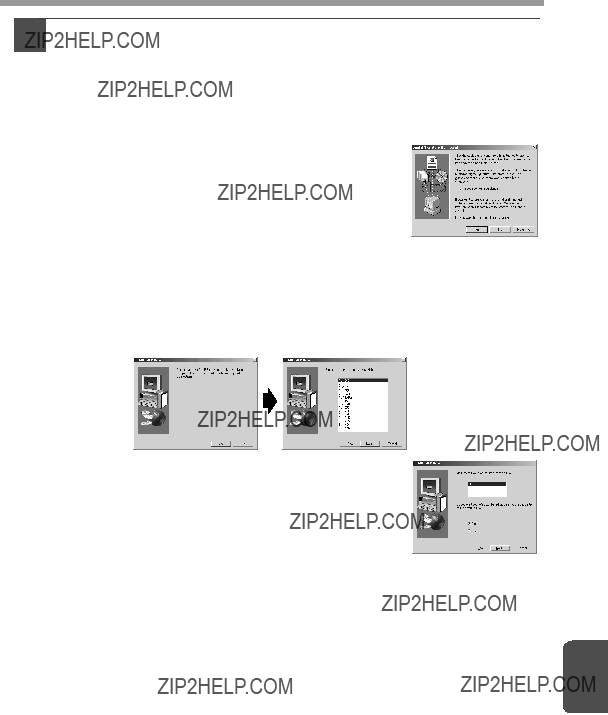
7 Copying files for MFP driver installation and parallel interface setup (This step will start if it was selected in step 4).
1After confirming the message in the "Welcome" window, click the "Next" button.
2A dialog box appears asking you to verify that the USB or parallel interface cable is not connected to the MFP. Make sure that the interface cable is not connected and click the "Next" button.
3Click the "Next" button in the dialog box to install the MFP driver or Cancel to quit the installation.
The setup program will start to copy the files.
In Windows 2000, if the following screen appears while the files are being copied (the message may appear more than once), click "Yes" in Windows 2000.
4The following screen appears. Click the "Yes" button, and then the Model screen will appear. Select the model number that is the same as the model name of your MFP and click the "Next" button.
Be sure to select the displayed model number that is the same as the MFP's model name. If they are not the same, the driver will not be installed correctly.
5 Establish the printer settings and click the "Next" button.
Select "LPT1" for the port to be used. If "LPT1" does not appear, it is likely that another printer or peripheral device is using "LPT1". Check your other printers and peripheral devices, and change the port setting as needed so no device is using "LPT1". If you wish the MFP to be your default printer, select "Yes". If not, select "No".
51
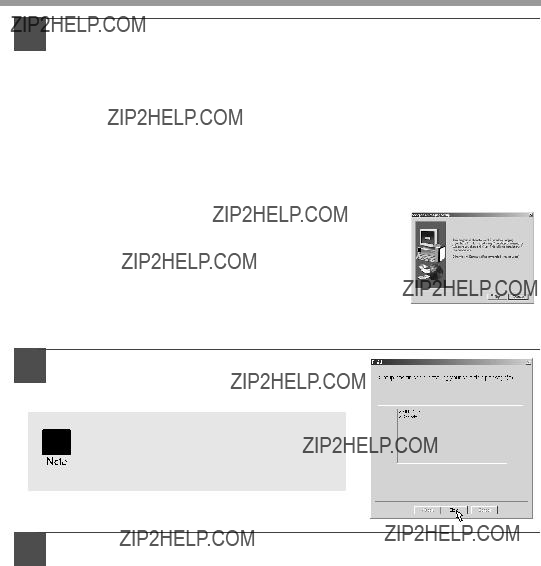
8 Begin installation of the Sharpdesk (This step will start if it was selected in step 4).
1After confirming the message in the "Welcome to Sharpdesk installation" window, click the "Next" button.
2Read the message in the "Information" window, and then click the "Next" button.
3When the "Choose Destination Location" window appears, click the "Next" button.
4When the "Select Program Folder" window appears, click the "Next" button.
The setup program will start to copy the files.
If the dialog box asking "If you have TIF files saved using Photoshop or Imaging for Windows you should hit Skip" appears, answer the question to continue the Sharpdesk installation.
5Click the "Finish" button when the message
to inform you of the completion of the installation appears.
9 Click the "Close" button when the message to inform you of the completion of the installation appears.
After the installation, a message to restart your computer may be displayed. In this case, click the "Yes" button to restart your computer.
10 Connect the parallel interface cable.
You have completed the installation of all the software.
52

INDICATORS ON THE OPERATION PANEL
The ONLINE indicator and the start ( ) indicator indicate the state of the printer or scanner.
) indicator indicate the state of the printer or scanner.
SCANNER indicator
ONLINE indicator
Start indicator
Power save indicator
Start indicator
ONLINE indicator
53

USING THE PRINTER MODE
For problems with the printer function, see the online manual or the help file for the driver.
Opening the printer driver from the start menu
Open the printer driver setup screen by the method shown below.
1
2
Click the "start" button.
Click "Control Panel", select "Printers and Other Hardware", and then click "Printers and Faxes".
On Windows 95/98/Me/NT4.0/2000, select "Settings" and click "Printers".
The procedure for loading paper is the same as for loading copy paper. See "LOADING PAPER" (p.7).
2
3
Open the document you intend to print, and select "Print" from the application's "File" menu.
Make sure that "SHARP
On Windows 95/98/Me/NT 4.0, click the "Properties" button.
On Windows 2000, the "Properties" button does not appear. Set your preferences by switching the tab in the "Print" dialog box.
54

4 Specify the print settings including the number of copies, media type, and print quality, and then click the "Print" button to start printing.
On Windows 95/98/Me/NT 4.0, click the "OK" button to start printing. For details on print settings, see the online manual or the help file for the printer driver.
??? If copying is being performed when printing is started, copying will continue. After copying is complete, printing will be executed when the clear ( ) key is pressed twice, the ONLINE key is pressed to switch the unit to the online state or approximately 60 seconds (auto clear time)* elapse.
) key is pressed twice, the ONLINE key is pressed to switch the unit to the online state or approximately 60 seconds (auto clear time)* elapse.
*The auto clear time varies with a user program setting. See "USER PROGRAMS" (p.23).
???Preheat mode and auto power
???If the paper size specified from the software application is larger than the paper size in the printer, part of the image that is not transferred to the paper may remain on the surface of the drum. In this case, the backside of the paper may become dirty. If this occurs, change to the correct size paper and print two or three pages to clean the image.
???If you start a print job while a scan job is in progress, the print data will be stored in the unit's memory. When the scan job is completed, printing will begin.
About interrupt copying
If you press the start (  ) key to begin a copy job while a print job using the paper tray or
) key to begin a copy job while a print job using the paper tray or  ) key twice, or press the ONLINE key once to change the unit to the online state (p.53), or wait until the set auto clear time (p.22) elapses. The remaining print data will be sent to the unit and printing will resume.
) key twice, or press the ONLINE key once to change the unit to the online state (p.53), or wait until the set auto clear time (p.22) elapses. The remaining print data will be sent to the unit and printing will resume.
8
55

USING THE SCANNER MODE
For problems with the scanner function, see the online manual or the help file for the driver.
Using the Button Manager
Setting up the Button Manager
The scanner driver for this unit includes an STI (Still image) driver and WIA (Windows Image Acquisition) driver. You can install software that supports the STI driver and WIA driver to enable scanning using only the operation panel of the unit. The Button Manager accessory software supports the STI driver and WIA driver. Setup that is required in Windows to use the Button Manager is explained in the following.
Windows XP
1
2
3
4
Click the "start" button, select "Control Panel" and click "Printers and Other Hardware", and then click "Scanners and Cameras" in the start menu. Right click the "SHARP
In the "Properties" screen, click the "Events" tab.
Click the "Select an event" button and select "ScanMenu SC1" from the
Repeat Step3 to set "ScanMenu SC2" through "ScanMenu SC6" .
Click the "Select an event" button and select "ScanMenu SC2" from the pull- down menu. Select "Button Manager (SHARP Personal MFP series)" in "Start this program" and click "Apply". Do the same for each ScanMenu through "ScanMenu SC6".
When the settings have been completed, click the "OK" button to close the screen. When the settings have been completed in Windows, start the Button Manager. Adjust detailed settings and then scan an image from the unit. For the procedures for starting Button Manager and adjusting settings, see "Scan Button Destination Setting Dialog Box" (p.58).
56
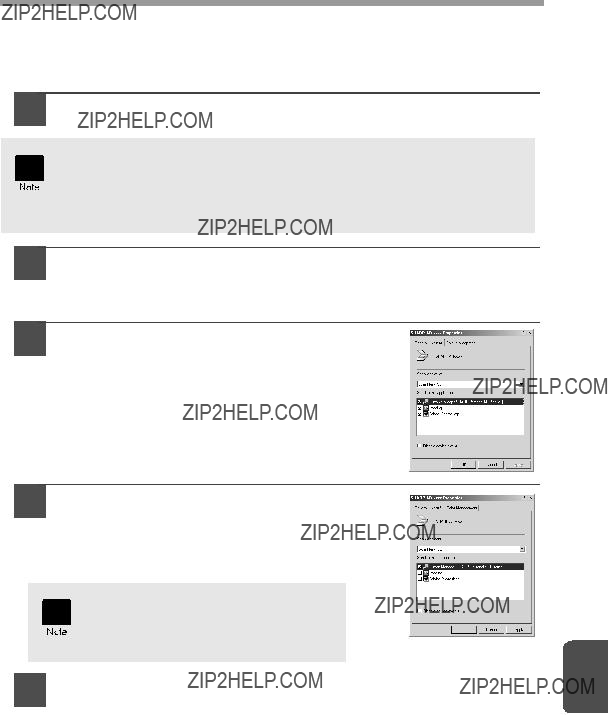
Windows 98/Me/2000
To scan directly into an application using the Button Manager on Windows 98, Windows Me and Windows 2000. Set the Event Manager properties to send only to Button Manager as shown below.
1 Click the "Start" button, select "Control Panel" from "Settings", and open "Scanners and Cameras" in start menu.
In Windows Me, it occasionally happens that the "Scanners and Cameras" icon does not appear immediately after installation of the MFP driver is completed. If the icon does not appear, click "View all Control Panel options" in the Control Panel and display the "Scanner and Cameras" icon.
2
3
4
5
Select
In Windows Me, right click
In the "Properties" screen, click the "Events" tab.
Click the "Scanner events" button and select "ScanMenu SC1" from the
If other application are shown, deselect the checkboxes for the other applications and leave only the Button Manager checkbox selected.
Click the "Scanner events" and select "ScanMenu SC2" from the
When the settings have been completed, click the "OK" button to close the screen. When the settings have been completed in Windows, start the Button Manager. Adjust detailed settings and then scan an image from the unit. For the procedures for starting Button Manager and adjusting settings, see "Scan Button Destination Setting Dialog Box" (Next page).
57

Scan Button Destination Setting Dialog Box
After you have completed the Button Manager settings in Windows, configure the scan settings in Button Manager. To configure the scan settings in Button Manager, right click the (  ) icon in the Taskbar and select "Setting" from the menu that appears.
) icon in the Taskbar and select "Setting" from the menu that appears.
For details on configuring the scan settings in Button Manager, see the online manual or the help file.
This is the corresponding setting in the Button Manager to automatically send multiple images from the RSPF/SPF in full color at 75 dpi to Sharpdesk using the operation panel "SC1" SCANNER ( ) key selection.
) key selection.
This dialog shows the SC1 event set to go directly to Button Manager. With the Button Manager set to send the image to Sharpdesk. (factory default setting) Sharpdesk will open after acquiring the image automatically.
Flow of the Button Manager setting
The Button Manager can directly handle a
This will scan directly into your application from the device.
58
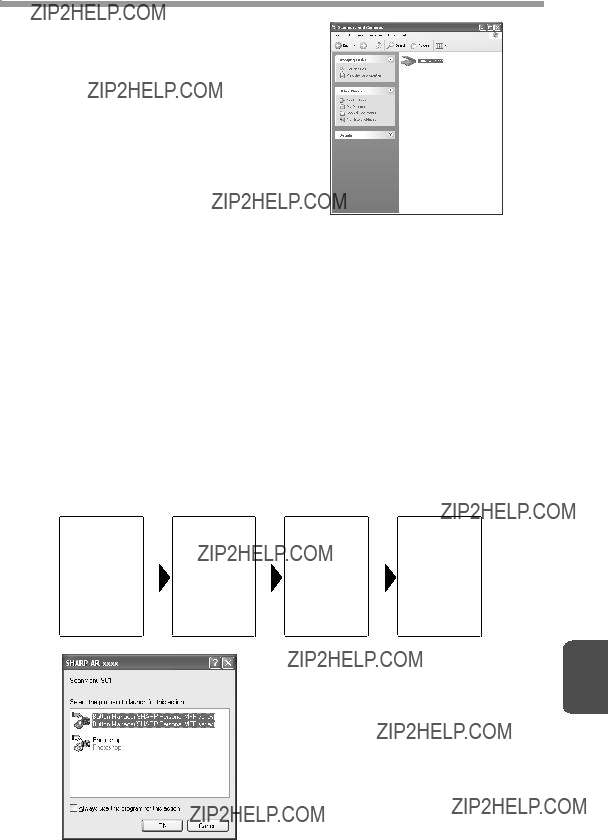
The settings for the Windows Event Manager for the SHARP
This can be done with the Windows OS showing the Event Manager selection dialog or directly into a selected application if the Button Manager is the only allowed handler for device events from the SHARP
This is done by changing the Windows device settings for the
This is the Control Panel Properties dialog for "Scanners and Cameras".
All About The Windows Event Manager and scanner events in Windows 98, Windows Me, Windows 2000 and Windows XP.
Windows Platforms provide a mechanism for software to handle external events for a scanner device like the SHARP
This is the Windows Event Manager
Selection Dialog.8 Shown are two applications registered
to handle the scanner event from the
59

Using the SCANNER key to begin scanning
??? Scanning is not possible during a copy job.
??? If the unit is used to begin a scan job during a print job, the scan job will be stored and scanning will begin when the print job is completed.
???When scanning an original that has been placed in the RSPF/SPF, only one original can be placed unless you are using Sharpdesk.
1
2
3
Press the SCANNER ( ) key.
) key.
The unit enters scan mode.
Place the original you wish to scan on the original table/RSPF/ SPF.
For the procedure for placing the original, see "ORIGINAL PLACEMENT" (p.14).
Press the right copy quantity key to display the number of the application that you wish to use for scanning.
The application numbers are initially as follows.
60

The selected application launches and scanning begins.
If the following screen appears, select Button Manager and click "OK". Button Manager starts and the application associated with Button Manager starts. If you want only Button Manager to start in this case, set up Button Manager for use in Windows as explained in "Setting up the Button Manager" (p.56).
Opening the scanner driver and scanning from your computer
Follow the steps below to open the scanner driver setup screen. As an example, this instruction is given using Sharpdesk as an image capture application.
??? Scanning is not possible during a copy and print job.
??? The method for starting the scanner driver differs depending on the type of application. Refer to the manual or the help file of your application.
???When using the scanner driver to scan an original that has been placed in the RSPF/SPF. If you perform a
61

If you use more than one scanning device, select the scanner you want to use through the application. The method for accessing the "Select Scanner" option, depends upon the application. For more information, see the online manual or the help file of your application.
4
5
Select "Acquire Image" from the "File" menu, or click the "Acquire" button ( ) .
) .
Set the configuration for scanning (refer to the online manual and help file), and click the "Scan" button.
Scan is started.
62

Scanning with the "Scanner and Camera Wizard" in Windows XP
Windows XP includes as a standard feature an image scanning function. The procedure for scanning with the "Scanner and Camera Wizard" is explained here.
To cancel scanning, click the "Cancel" button in the screen that is displayed.
1
2
3
4
5
Place the original you wish to scan on the original table/RSPF/ SPF.
For the procedure for placing the original, see "ORIGINAL PLACEMENT" (p.14).
Click the "start" button , select "Control Panel", and click "Printers and Other Hardware", and then click "Scanners and Cameras" in the start menu. Click the "SHARP
The "Scanner and Camera Wizard" appears. Click "Next" and establish the basic settings for scanning.
For information on the settings, see the Windows XP help file. After completing each setting, click "Next".
Select a name, format, and folder for the scanned image.
For information on the image name, file format, and folder, see the Windows XP help file.
For information on each selection, see the Windows XP help file. To quit the "Scanner and Camera Wizard", select "Nothing. I???m finished working with these pictures." and click "Next".
6 Click "Finish" in the screen that appears.
The "Scanner and Camera Wizard" closes and the scanned image is saved.
63
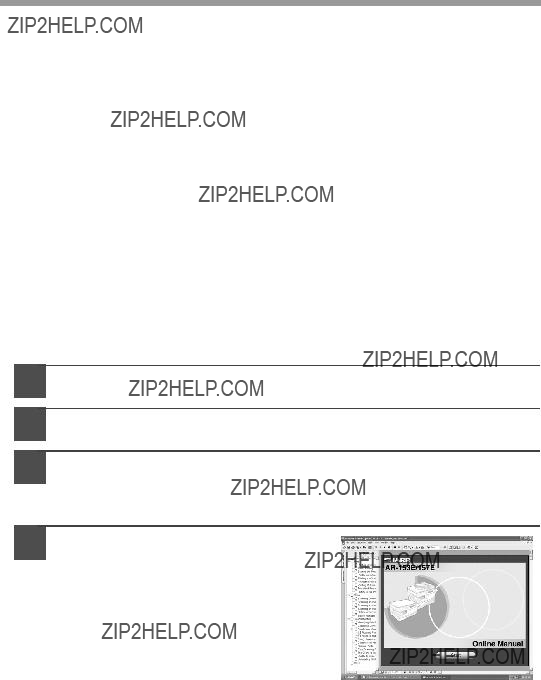
HOW TO USE THE ONLINE MANUAL
The online manual provides detailed instructions for operating the unit as the printer or scanner and a list of methods for dealing with printing or scanner problems.
To access the online manual, your computer must have Acrobat Reader 5.0 or a later version. If it is not installed, refer to "Installing Acrobat Reader" (Next page).
Contents of the online manual
The contents of the online manual are as follows. Check the online manual when you use this unit after all the initial setup is completed.
How to use the online manual
Explains how to use the online manual.
Provides information on how to print a document.
Scan
Explains how to scan using the scanner driver and how to adjust the settings for the Button Manager.
Troubleshooting
Provides instructions on how to solve driver or software problems.
1
2
3
Turn on your computer.
Insert the supplied
Click the "start" button, click "My Computer" (  ), and then
), and then  ) icon.
) icon.
On Windows 95/98/Me/NT 4.0/2000,  ), and then
), and then  ) icon.
) icon.
4
The following window will appear.
64

To close the online manual, click the (  ) button located at the
) button located at the
??? The online manual can be printed out using Acrobat Reader. SHARP recommends printing out the sections which you refer to regularly.
??? Refer to "Help" of Acrobat Reader for more details on the operation and function of Acrobat Reader.
Installing Acrobat Reader
1
2
3
Turn on your computer.
Insert the
Click the "start" button, click "My Computer" (  ), and then
), and then  ) icon.
) icon.
Windows95/98/Me/NT4.0/2000,  ), and then
), and then  ) icon.
) icon.
4
Follow the
8
65
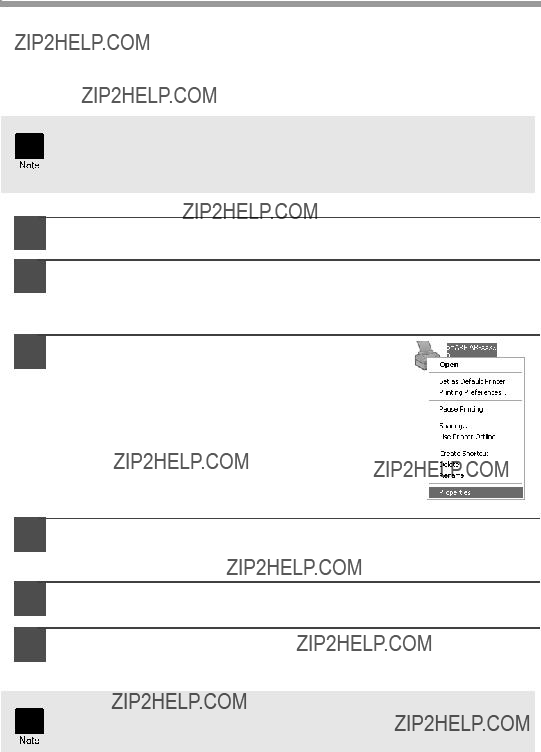
USING OTHER INSTALLED DRIVERS
If you use another GDI printer or a Windows Printing System printer, interference between printers may occur and printing may not be performed properly. To use another GDI printer or a Windows Printing System printer, you must change the port setting of the printer driver using the following procedure.
If another printer does not operate properly when the SHARP Personal MFP series printer driver is set to "FILE" as described below, uninstall the SHARP Personal MFP series printer driver. To uninstall the printer driver, see the online manual.
1
2
3
4
5
6
Click the "start" button.
Click "Control Panel", click "Printer and Other Hardware" and then click "Printer and Faxes".
On Windows 95/98/Me/NT4.0/2000, select "Settings" and then click "Printers".
Click the "Port" tab ("Details" tab - on Windows 95/98/Me) in the "Properties" dialog box, select "FILE": in the "Print to the following port" list box, and click the "OK".
Click the "Port" tab ("Details" tab - on Windows 95/98/Me) in the "Properties" window, select "LPT1" (or the currently used port), and click the "OK" button.
To use the SHARP Personal MFP series again, perform the same procedure but select the port to be used (for example, LPT1) in step 4.
66
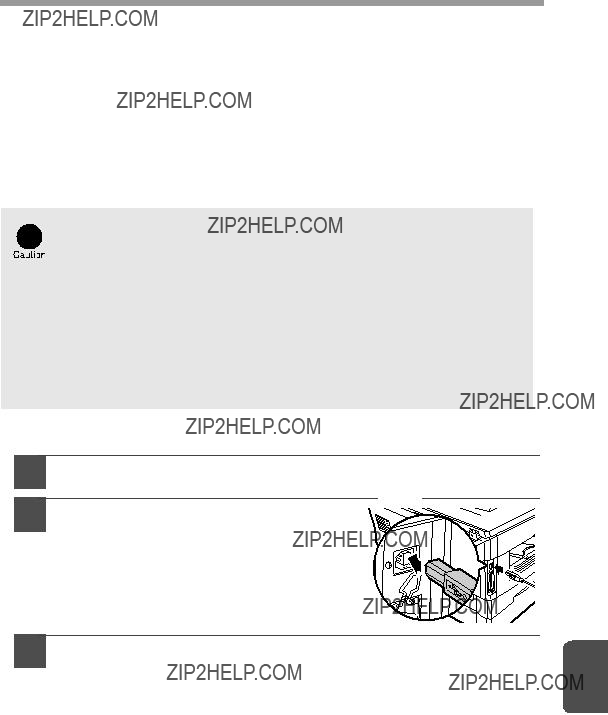
CONNECTING THE INTERFACE CABLE
This unit includes both USB and parallel interface connectors.
Interface cables for connecting the unit to your computer are not included with this unit. Please purchase the appropriate cable for your computer.
Interface cable
Parallel interface cable
IEEE
USB interface cable
Shielded twisted pair cable,
??? If you intend to use the unit as a scanner, it must be connected to your computer with a USB interface cable. The scanner function cannot be used if the unit is connected with a parallel cable.
???USB is available with a PC/AT compatible computer that was originally equipped with USB and had Windows 98, Windows Me, Windows 2000 Professional, Windows XP Professional or Windows XP Home Edition preinstalled.
???Do not connect the interface cable before installing the MFP driver. The interface cable should be connected during installation of the MFP driver. (p.43)
Connecting the USB interface cable
1
2
3
Obtain a shielded USB interface cable.
Insert the cable into the USB interface connector located on the rear of the unit.
67

Connecting the parallel interface cable
1
2
3
Obtain an IEEE1284 shielded parallel interface cable.
Ensure that your computer and unit are turned off.
Insert the cable into the parallel interface connector located on the rear of the unit, and fasten with clasps.
4 Insert the other end of the cable into the interface connector of your computer.
68

9
69
70

Optional equipment
Printer/Scanner Expansion Kit
*1 Feed paper lengthwise only.
*2 Data transmission time is not included.
Single pass feeder
As a part of our policy of continuous improvement, SHARP reserves the right to make design and specification changes for product improvement
without prior notice. The performance specification figures indicated are 9 nominal values of production units. There may be some deviations from
these values in individual units.
71

INDEX
2
A
Alarm indicator
- Developer replacement required
B
C
72

73

Z
INDEX BY PURPOSE
74
SOFTWARE LICENSE
PLEASE READ THIS LICENSE CAREFULLY BEFORE USING THE SOFTWARE. BY
USING THE SOFTWARE, YOU ARE AGREEING TO BE BOUND BY THE TERMS OF
THIS LICENSE.
1. License.
The application, demonstration, system and other software accompanying this License, whether on disk, in read only memory, or on any other media (the "Software") and related documentation are licensed to you by SHARP. You own the disk on which the Software is recorded but SHARP and/or SHARP'S Licensors retain title to the Software and related documentation. This License allows you to use the Software on one or more computers connected to a single printer and make one copy of the Software in
2. Restrictions.
The Software contains copyrighted material, trade secrets and other proprietary material which is owned by SHARP and/or its Licensors and in order to protect them you may not decompile, reverse engineer, disassemble or otherwise reduce the Software to a
3. Termination.
This license is effective until terminated. You may terminate this License at any time by destroying the Software and related documentation and all copies thereof. This License will terminate immediately without notice from SHARP and/or SHARP???S Licensors if you fail to comply with any provision of this License. Upon termination you must destroy the Software and related documentation and all copies thereof.
4. Export Law Assurances.
You agree and certify that neither the Software nor any other technical data received from SHARP, nor the direct product thereof, will be exported outside the United States except as authorized and as permitted by the laws and regulations of the United States. If the Software has been rightfully obtained by you outside of the United States, you agree that you will not
5. Government End Users.
If you are acquiring the Software on behalf of any unit or agency of the United States Government, the following provisions apply. The Government agrees:
(i)if the Software is supplied to the Department of Defense (DoD), the Software is classified as "Commercial Computer Software" and the Government is acquiring only "restricted rights" in the Software and its documentation as that term is defined in Clause
(ii)if the Software is supplied to any unit or agency of the United States Government other than DoD, the Government's rights in the Software and its documentation will be as defined in Clause 52.227- 19 (c)(2) of the FAR or, in the case of NASA, in Clause
75
6. Limited Warranty on Media.
SHARP warrants the disks on which the Software is recorded to be free from defects in materials and workmanship under normal use for a period of ninety (90) days from the date of purchase as evidenced by a copy of the receipt. The entire liability of SHARP and/or its Licensors and your exclusive remedy will be replacement of the disk which fails to meet the limited warranty provided by this Clause 6. A disk will be replaced when it is returned to SHARP or a SHARP authorized representative with a copy of the receipt. SHARP will have no responsibility to replace a disk damaged by accident, abuse or misapplication.
ANY IMPLIED WARRANTIES ON THE DISKS, INCLUDING THE IMPLIED WARRANTIES OF
MERCHANTABILITY AND FITNESS FOR A PARTICULAR PURPOSE, ARE LIMITED IN
DURATION TO NINETY (90) DAYS FROM THE DATE OF DELIVERY. THIS WARRANTY GIVES
YOU SPECIFIC LEGAL RIGHTS, AND YOU MAY ALSO HAVE OTHER RIGHTS WHICH VARY
FROM JURISDICTION TO JURISDICTION.
7. Disclaimer of Warranty on Software.
You expressly acknowledge and agree that use of the Software is at your sole risk. The software and related documentation are provided "AS IS" and without warranty of any kind and SHARP and SHARP'S Licensor(s) (for the purpose of provisions 7 and 8, SHARP and SHARP'S Licensor(s) shall be collectively referred to as "SHARP") EXPRESSLY DISCLAIM ALL WARRANTIES, EXPRESS OR
IMPLIED, INCLUDING, BUT NOT LIMITED TO, THE IMPLIED WARRANTIES OF
MERCHANTABILITY AND FITNESS FOR A PARTICULAR PURPOSE. SHARP DOES NOT
WARRANT THAT THE FUNCTIONS CONTAINED IN THE SOFTWARE WILL MEET YOUR
REQUIREMENTS, OR THAT THE OPERATION OF THE SOFTWARE WILL BE
UNINTERRUPTED OR
CORRECTED. FURTHERMORE, SHARP DOES NOT WARRANT OR MAKE ANY
REPRESENTATIONS REGARDING THE USE OR THE RESULTS OF THE USE OF THE
SOFTWARE OR RELATED DOCUMENTATION IN TERMS OF THEIR CORRECTNESS,
ACCURACY, RELIABILITY, OR OTHERWISE. NO ORAL OR WRITTEN INFORMATION OR
ADVICE GIVEN BY SHARP OR A SHARP AUTHORIZED REPRESENTATIVE SHALL CREATE A
WARRANTY OR IN ANY WAY INCREASE THE SCOPE OF THIS WARRANTY. SHOULD THE
SOFTWARE PROVE DEFECTIVE, YOU (AND NOT SHARP OR A SHARP AUTHORIZED
REPRESENTATIVE) ASSUME THE ENTIRE COST OF ALL NECESSARY SERVICING, REPAIR
OR CORRECTION, SOME JURISDICTIONS DO NOT ALLOW THE EXCLUSION OF IMPLIED
WARRANTIES, SO THE ABOVE EXCLUSION MAY NOT APPLY TO YOU.
8. Limitation of Liability.
UNDER NO CIRCUMSTANCES INCLUDING NEGLIGENCE, SHALL SHARP BE LIABLE FOR
ANY INCIDENTAL, SPECIAL OR CONSEQUENTIAL DAMAGES THAT RESULT FROM THE
USE OR INABILITY TO USE THE SOFTWARE OR RELATED DOCUMENTATION, EVEN IF
SHARP OR A SHARP AUTHORIZED REPRESENTATIVE HAS BEEN ADVISED OF THE
POSSIBILITY OF SUCH DAMAGES. SOME JURISDICTIONS DO NOT ALLOW THE
LIMITATION OR EXCLUSION OF LIABILITY FOR INCIDENTAL OR CONSEQUENTIAL
DAMAGES SO THE ABOVE LIMITATION OR EXCLUSION MAY NOT APPLY TO YOU.
In no event shall SHARP'S total liability to you for all damages, losses, and causes of action (whether in contract, tort (including negligence) or otherwise) exceed the amount paid by you for the Software.
9. Controlling Law and Severability.
For a portion of the Software related with Apple Macintosh and Microsoft Windows, this license shall be governed by and construed in accordance with the laws of the state of California and Washington, respectively. If for any reason a court of competent jurisdiction finds any provision of this License, or portion thereof, to be unenforceable, that provision of the License shall be enforced to the maximum extent permissible so as to effect the intent of the parties, and the remainder of this License shall continue in full force and effect.
10. Complete Agreement.
This License constitutes the entire agreement between the parties with respect to the use of the Software and related documentation, and supersedes all prior or contemporaneous understandings or agreements, written or oral, regarding such subject matter. No amendment to or modification of this License will be binding unless in writing and signed by a duly authorized representative of SHARP.
76
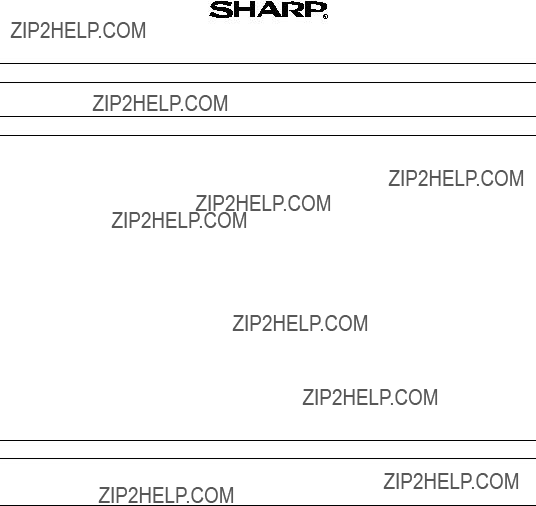
Date Issued:Nov. 1, 2000
MATERIAL SAFETY DATA SHEET
MSDS No.
Section 1. Product Identification
Product:
Section 2. Supplier???s Name and Address
Sharp Corporation
Local suppliers are listed below. Please contact the nearest supplier for additional information.
Section 4. Hazardous Identification (Emergency Overview)
Toner is a fine, black powder possessing no immediate hazard. There are no anticipated carcinogenic effects from exposure based on animal tests performed using toner. When used as intended according to instructions, studies do not indicate any symptoms of fibrosis will occur.
Health Hazards: Acute oral toxicity
Carcinogenicity: In 1996 the IARC reevaluated carbon black as a Group 2B carcinogen (possible human carcinogen). This classification is given to chemicals for which there is inadequate human evidence, but sufficient animal evidence on which to base an opinion of carcinogenicity. The classification is based upon the development of lung tumors in rats receiving chronic inhalation exposures to free carbon black at levels that induce particle overload of the lung. Studies performed in animal models other than rats did not show any association between carbon black and lung tumors. Moreover, a
Chronic Effect: In a study in rats of chronic inhalation exposure to a typical toner, a mild to moderate degree of lung fibrosis was observed in 92% of the rats in the high concentration (16mg/m3) exposure group, and a minimal to mild degree of fibrosis was noted in 22% of the animals in the middle (4mg/m3) exposure group, but no pulmonary change was reported in the lowest (1mg/m3) exposure group, the most relevant level to potential human exposures.
Signs and Symptoms of Exposure: Minimal irritation to respiratory tract may occur as with exposure
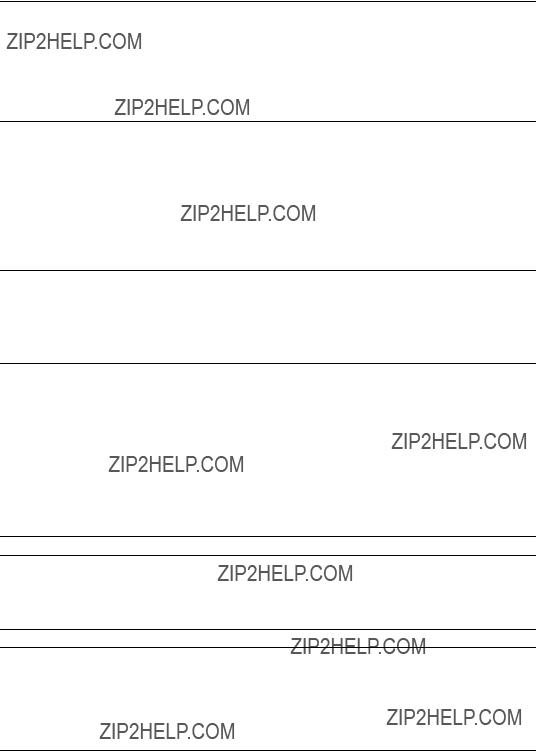
Section 10. Regulatory Information
Section 11. Other Information
References: IARC (1996) IARC Monographs on the Evaluation of the Carcinogenic Risk of Chemicals to Humans, Vol. 65, Printing Process and Printing inks, Carbon Black and Some Nitro Compounds, Lyon,
H. Muhle, B. Bellmann, O. Creutzenberg, C. Dasenbrock, H. Ernst, R. Kilpper, J. C. MacKenzie, P. Morrow, U. Mohr, S. Takenaka, and R. Mermelstein (1991) Pulmonary Response to Toner upon Chronic Inhalation Exposure in Rats. Fundamental and Applied Toxicology 17, pp.

Date Issued :Nov. 1, 2000
MATERIAL SAFETY DATA SHEET
MSDS No.
Section 1. Product Identification
Product
Section 2. Supplier???s Name and Address
Sharp Corporation
Local suppliers are listed below. Please contact the nearest supplier for additional information.
Section 4. Hazardous Identification (Emergency Overview)
Developer is a black powder containing small amounts of toner, and possessing no immediate hazard. There are no anticipated carcinogenic effects from exposure based on animal tests performed using toner.
Health Hazards: Acute oral toxicity
Mutagenicity
Carcinogenicity: In 1996 the IARC reevaluated carbon black as a Group 2B carcinogen (possible human carcinogen). This classification is given to chemicals for which there is inadequate human evidence, but sufficient animal evidence on which to base an opinion of carcinogenicity. The classification is based upon the development of lung tumors in rats receiving chronic inhalation exposures to free carbon black at levels that induce particle overload of the lung. Studies performed in animal models other than rats did not show any association between carbon black and lung tumors. While there have been no studies to date using developer, a
Signs and Symptoms of Exposure: Minimal irritation to respiratory tract may occur as with exposure to any
Medical Conditions Generally Aggravated by Exposure: None
Emergency and First Aid Procedures:

Section 10. Regulatory Information
Section 11. Other Information
References: IARC (1996) IARC Monographs on the Evaluation of the Carcinogenic Risk of Chemicals to Humans, Vol. 65, Printing Process and Printing inks, Carbon Black and Some Nitro Compounds, Lyon,
H. Muhle, B. Bellmann, O. Creutzenberg, C. Dasenbrock, H. Ernst, R. Kilpper, J. C. MacKenzie, P. Morrow, U. Mohr, S. Takenaka, and R. Mermelstein (1991) Pulmonary Response to Toner upon Chronic Inhalation Exposure in Rats. Fundamental and Applied Toxicology 17, pp.

NOTICE
BE SURE TO ASK YOUR AUTHORIZED SHARP DEALER ABOUT THE WARRANTY THAT YOUR SELLING DEALER EXTENDS TO YOU. In order to assure you, the
YOU, THE
MERCHANTABILITY, FITNESS FOR USE OR FITNESS FOR ANY PARTICULAR PURPOSE IN
CONNECTION WITH THE HARDWARE, SOFTWARE OR FIRMWARE EMBODIED IN, OR USED IN CONJUNCTION WITH THIS PRODUCT. Sharp is not responsible for any damages or loss, either direct, incidental or consequential, which you, the
In the event that this authorized dealer does not honor its warranty commitments, please contact the General Manager, Business Products Group, Sharp Electronics Corporation, Sharp Plaza, Mahwah,
This product utilizes
Disposal of these materials may be regulated due to environmental considerations.
For disposal or recycling information, please contact your local authorities or the Electronics Industries Alliance: www.eia.org
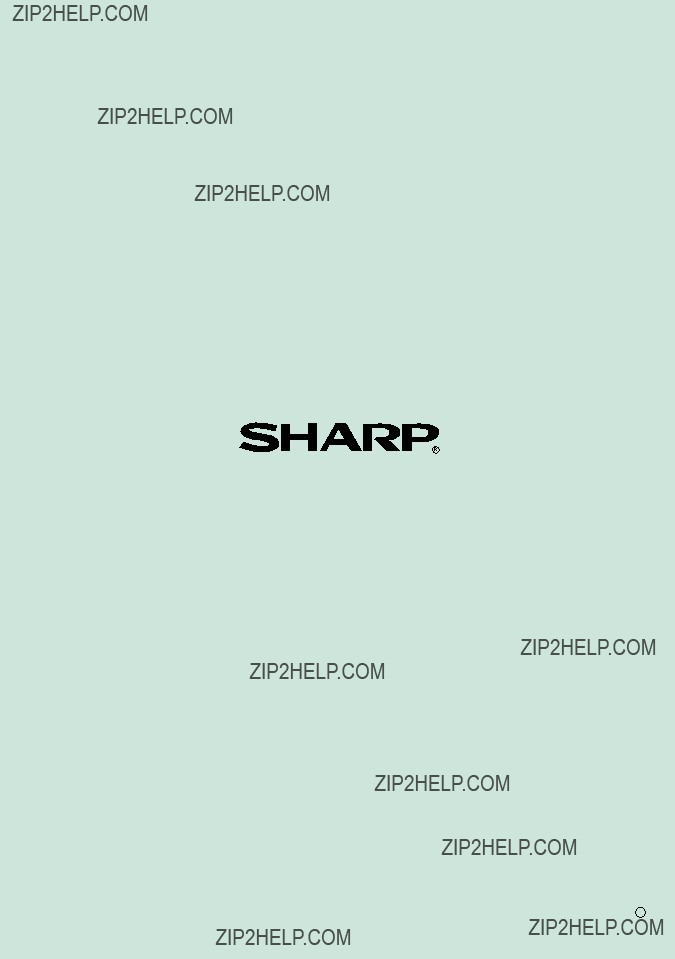
SHARP ELECTRONICS CORPORATION
Sharp Plaza, Mahwah, New Jersey
2002G KS 1 TINSE0800QSZZ

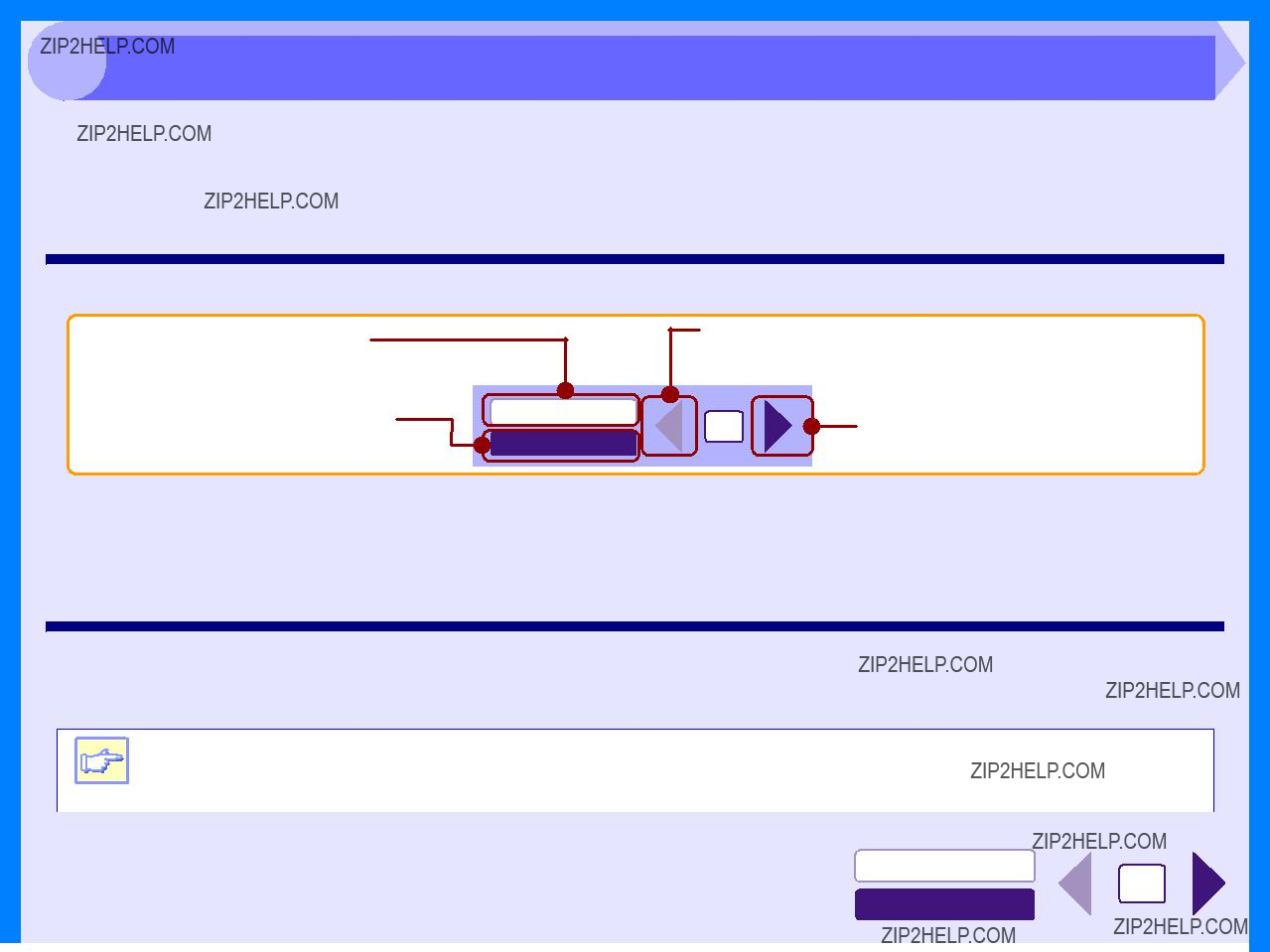
1 How to Use the Online Manual
This Online Manual provides instruction for the operation of your new unit. Please read the following explanation of how to use the Online Manual, and then search for the information that you need.
For more information about computers, operating systems and Acrobat Reader, please refer to the relevant manual or help file.
How to Control the Online Manual
Click this button to display the Table of Contents of the Online Manual. From the Table of Contents you can jump to various pages.
Click this button to display the Index of the Online Manual. From the Index you can jump to various pages.
Takes you back page by page. To return to the previous link, click the ( ) button on the menu bar of the Acrobat Reader.
) button on the menu bar of the Acrobat Reader.
Following links
Links can connect parts of a document to other parts for further information. In this document, green colored letters are linked areas.
To follow a link, select a hand tool ( ), a zoom tool or a selection tool. Position the pointer over the linked area on the page until the pointer changes to a hand with a pointing finger (
), a zoom tool or a selection tool. Position the pointer over the linked area on the page until the pointer changes to a hand with a pointing finger (  ). Then click the link.
). Then click the link.
Using Bookmarks
This online manual has Bookmarks on the main pages of each section. You can move to the desired pages by simply clicking its bookmark.
How to Print Out the Online Manual
In order to print out a hard copy of the Online Manual for your reference, go to Acrobat Reader, click the "File" menu, and select "Print". After specifying the printer setting, click the "Print" ("OK" on Windows 95/98/Me/NT 4.0) button to print.
!In this online manual, screen images and operating procedures are mainly for Windows XP. With other versions of Windows, some screen images may be different from those in this manual.
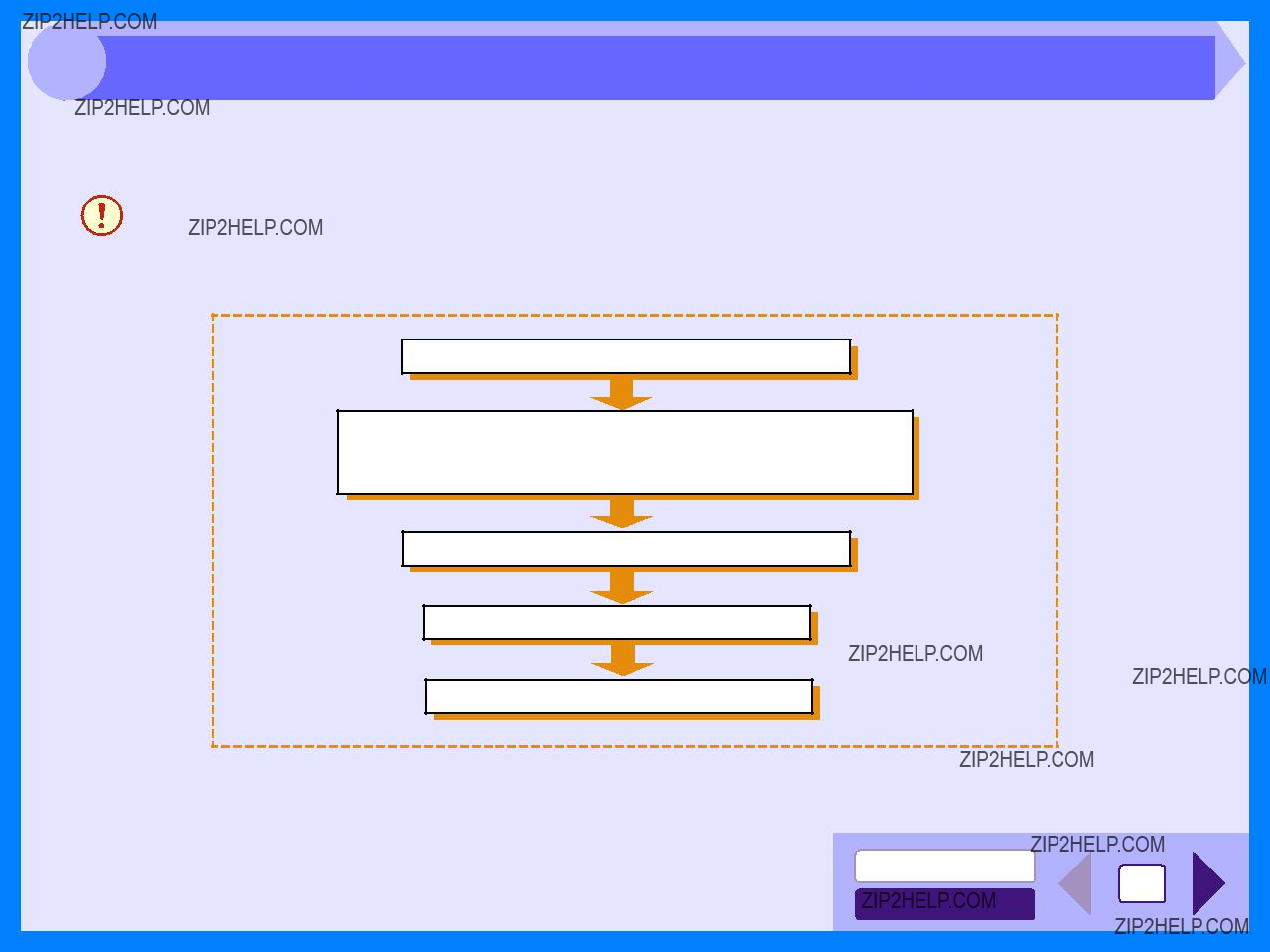
2 Printing Overview
The flow chart shown below provides printing overview.
Reference: For more information on printing, see Basic Printing.
Prepare the document you intend to print
Open the printer driver setup screen and set the print preferences
Reference:
Printer Driver Settings, Printing a Watermark, Fitting the Printed Image to the Paper,
Printing Multiple Pages on One Page,
Send print data from your computer
Printing
Exit printing

2 Basic Printing
This is a printing example using WordPad to print a document onto letter size paper.
1
2
Select "Print" from the application's "File" menu.
intend to change any print setting, click the "Preferences" button to open the printer driver setup screen.
On Windows 95/98/Me/NT 4.0, click the "Properties" button.
2 Click this button to change any print preference.
Reference: Printer Driver Settings, Printing a Watermark, Fitting the Printed Image to the Paper, Printing Multiple Pages on One Page,
Click here.
Printing starts according to your preferences.
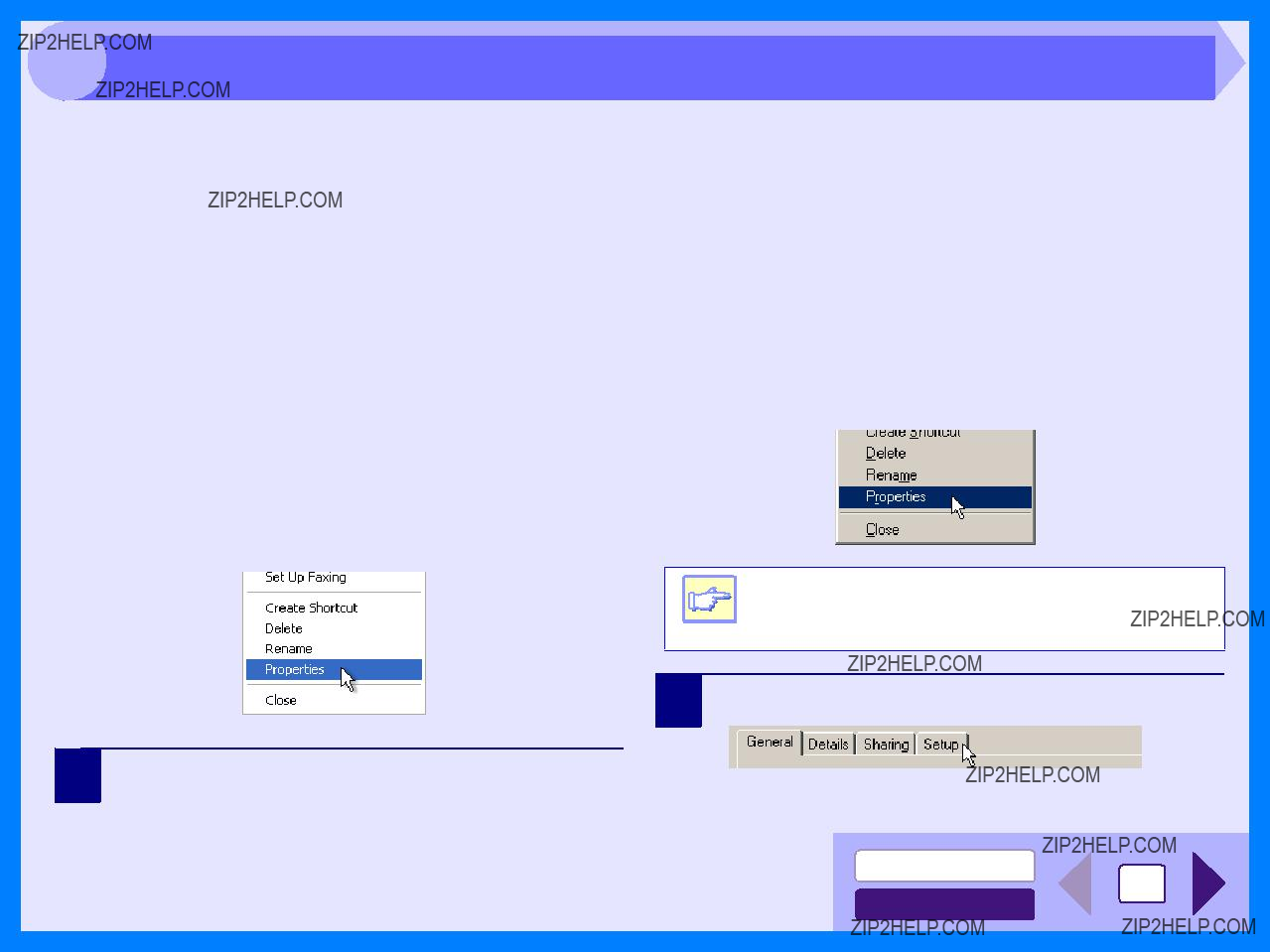
2 Starting the Printer Driver Using the "Start" Button
You can open the printer driver and change the printer driver settings from the Windows "start" button. Settings adjusted in this way will be the initial settings when you print from an application. (If you change the settings from the printer driver setup screen at the time of printing, the settings will revert to the initial settings when you quit the application.)
Windows 95/98/Me/NT 4.0
select "Properties" from the "File" menu.
On Windows NT 4.0, select "Document Defaults" to open the printer driver setup screen.
Note
3 On Windows 95/98/Me, click the "Setup" tab.
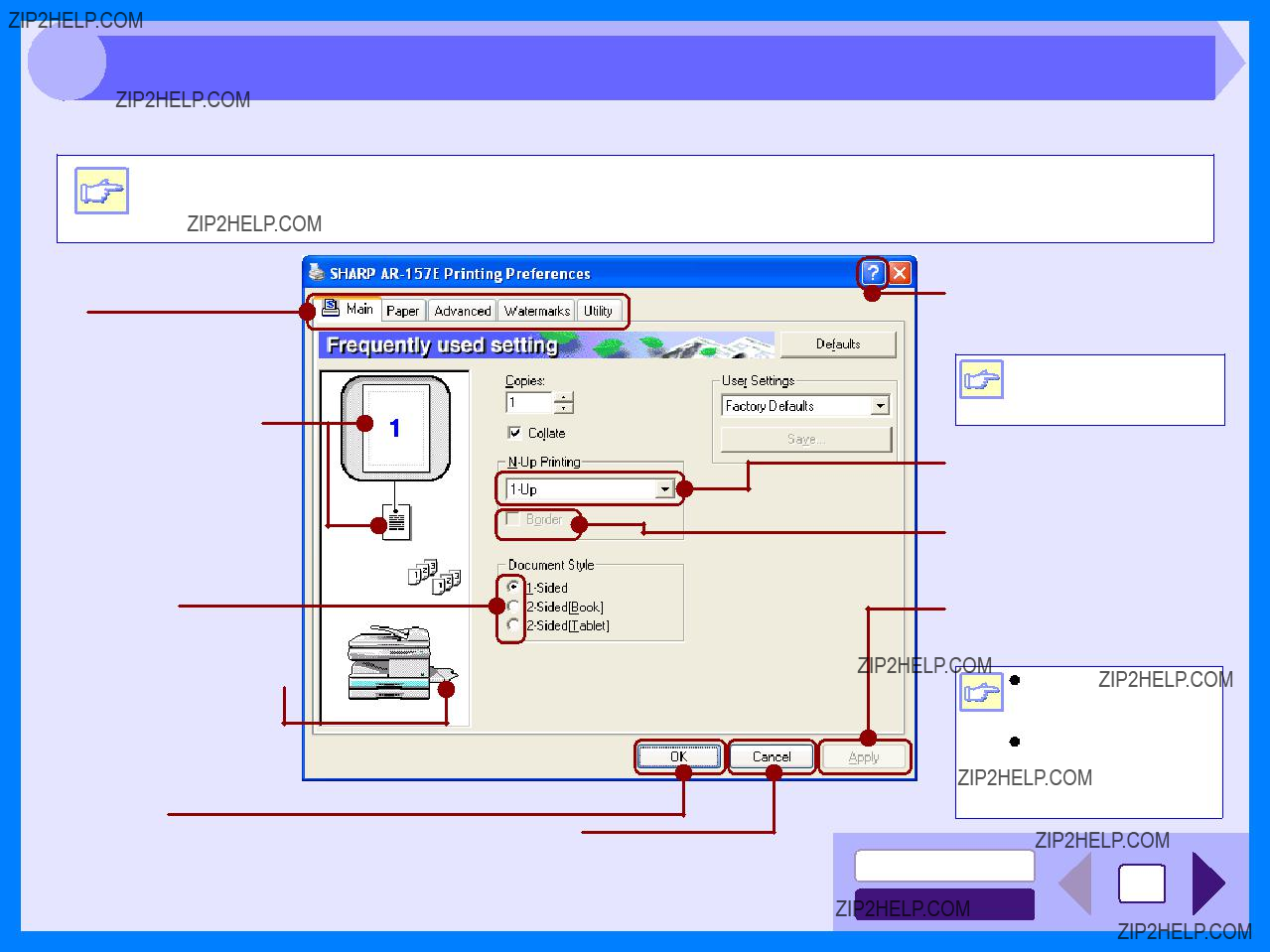
2 Printer Driver Settings
To view Help for a setting, click the ( ) button in the upper
) button in the upper
The
Note
Tab
Index which allows you to switch between the various setup screens.
The settings you made at
Check button
Allows you to select one item from a list of options.
The tray selected in  "Paper Selection" in the
"Paper Selection" in the
"Paper" tab appears in blue. You can also click on a tray to select it.
(  ) button
) button
Click this button and then click a setting to view Help for the setting.
You can also view Help by
Note with the mouse.
Allows you to make one selection from a list of choices.
Check box
Click this option to activate/ deactivate each function.
"Apply" button
Click to save your settings without closing the dialog box.
"OK" button
Click this button to save your settings, and exit the dialog box.
"Cancel" button
Click this button to exit the dialog box without making any changes to the settings.

2 Printing a Watermark
To print a watermark, for example "CONFIDENTIAL", on your document, refer to the following steps. Open the printer driver and click the "Watermarks" tab.
Reference: See Basic Printing for details on how to open the printer driver.
How to Print a Watermark
From the "Watermark"
Print sample
For details on watermark settings, view printer driver Help.
Reference: Printer Driver Settings

2 Fitting the Printed Image to the Paper
This printer driver can adjust the zoom ratio for printing according to the paper loaded in the unit.
Follow the steps shown below to use this function. The instruction below assumes that you intend to print a Letter size document onto an Invoice size paper.
The "Fit To Paper Size" setting is not available when
Reference: Printing Multiple Pages on One Page
Note
1
2
3

2 Printing Multiple Pages on One Page
This feature allows you to print two or four document pages onto a single page.
To use this function, open the printer driver setup screen, select
The
Reference: Fitting the Printed Image to the Paper
Note
If you select the "Border" checkbox, border lines will be printed on each page.

2
You can print on both sides of the paper.
To use this function, open the printer driver setup screen and select "2- Sided (Book)" or
When using
Note
The following example shows the result when portrait data is printed on both sides of the paper.
Printing result
Print data
The pages are printed so that they can be bound at the side.
The pages are printed so that they can be bound at the top.

2 Outline of the Print Status Window
When printing begins, the Print Status Window activates and appears on the screen.
The Print Status Window is a program designed to show the current printer status including the document name being printed and error messages.
Status icon
This icon informs you of the print status.
Tab
Index which allows you to switch between the two setup screens.
"Close" button
Click this button to close the Print Status Window.
 Status window
Status window
Provides details on the current status of the print job.
Document Name
Displays the name of the active print job.
"Cancel Job" button
Click this button during printing to cancel the job that is currently being executed.
"Help" button
Click this button to display help file for the Print Status Window.
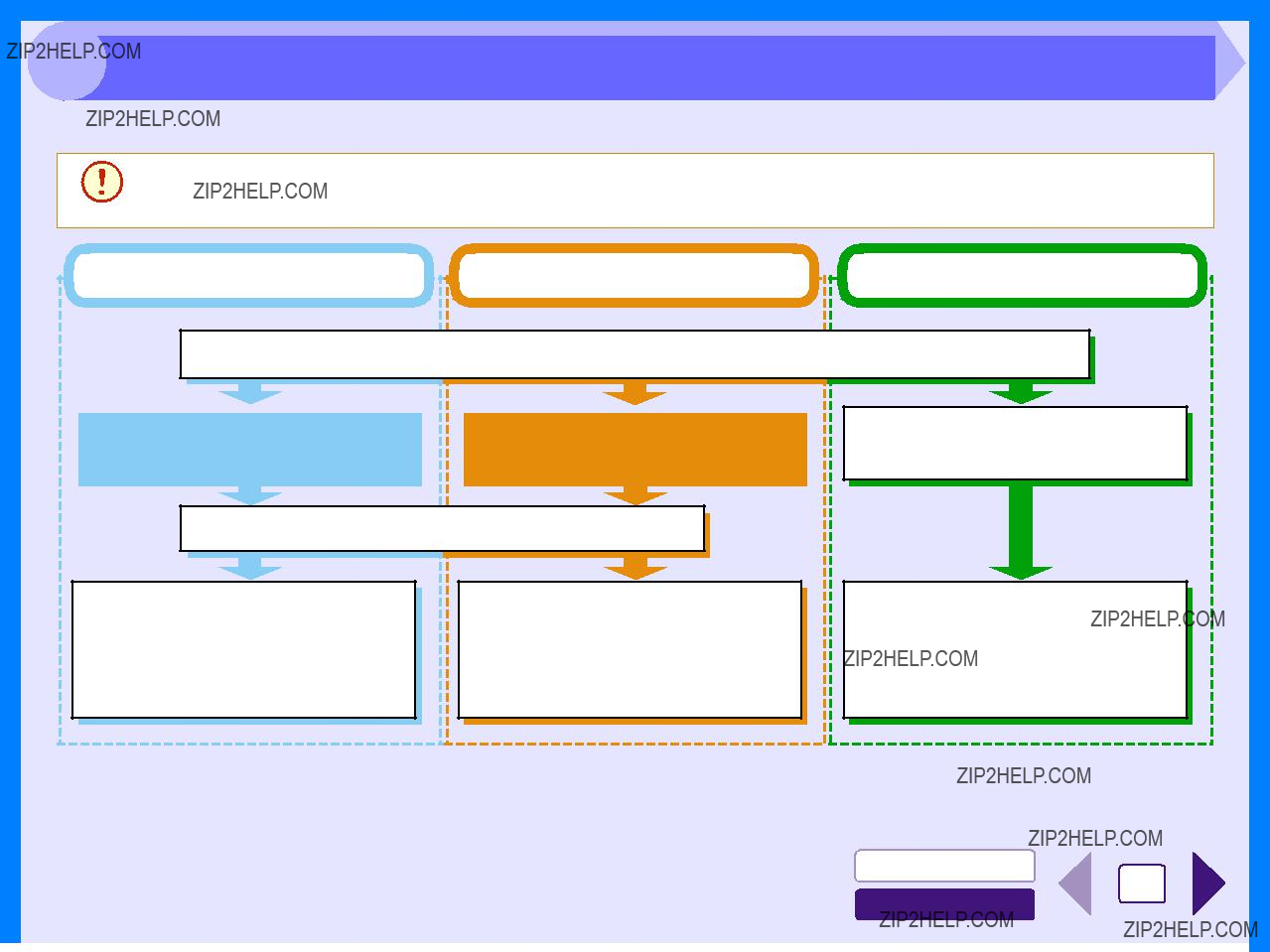
3 Scanning Overview
The flow chart shown below provides scanning overview.
Caution
The environment in which the unit's scanning function can be used is subject to certain limitations. For details, see "BEFORE INSTALLATION" in the Operation Manual.
Place the original in the scanning position
Reference: For more detail, refer to the "ORIGINAL PLACEMENT" in the Operation Manual.
Set the scan preferences
Change the unit to scanner mode and select scan menu (SC1 to SC6) on the operation panel.
Scanning
Reference: Scanning an Image from a
Scanning
Reference: Scanning an Image from the "Scanner and Camera Wizard" (Windows XP)
*1:TWAIN is an industry standard for interface of image data processing devices including scanners. By installing a TWAIN driver onto your computer, you can scan and work with images using a variety of
*2:WIA (Windows Imaging Acquisition) is a Windows function that allows a scanner, digital camera or other imaging device to communicate with an
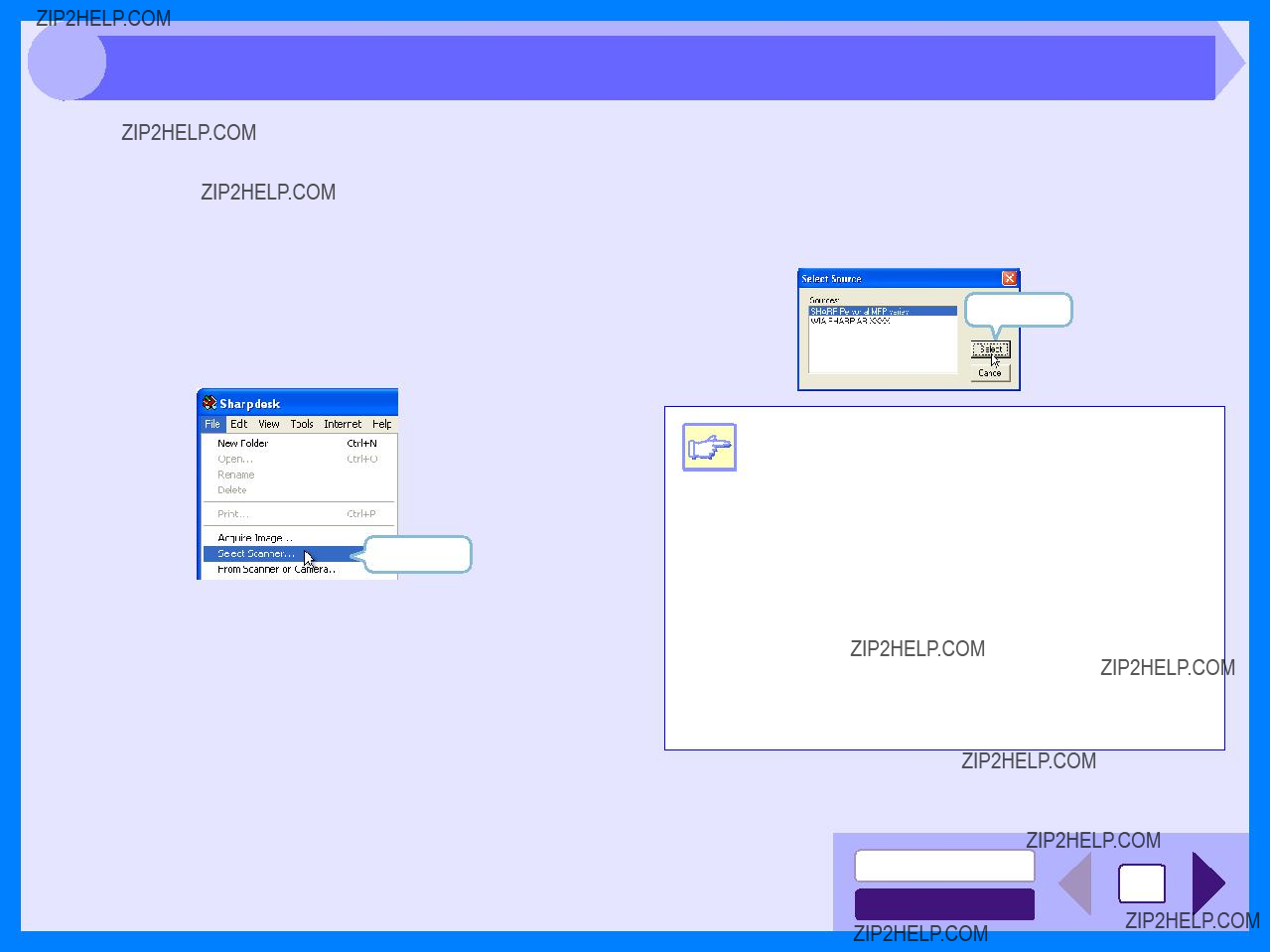
3 Scanning an Image from a
The SHARP scanner driver conforms to TWAIN, the industry standard, making it compatible with a variety of TWAIN- compliant applications. Below is a
Reference: For information on setting an original for scanning, refer to "ORIGINAL PLACEMENT" in the Operation Manual.
Click here.
Click here.
Reference: Scanning an Image from a WIA-
!Depending on your system, "SHARP Personal MFP series 1.0
!The method for accessing the "Select Scanner" option, depends upon the application. For more information, refer to the manual or the help file of your application.

3 Scanning an Image from a
The scanner driver setup screen will appear.
Reference: Scanner Driver Settings
("Platen" or "SPF").
Select "SPF" when you placed the original in the RSPF/SPF.
For information on specifying the scan area and setting the scan preferences, see scanner driver Help.
Reference: Scanner Driver Settings
button, press the [Esc] key on your keyboard.
When you close the scanner driver after scanning, the image data will appear as a new file in Sharpdesk.
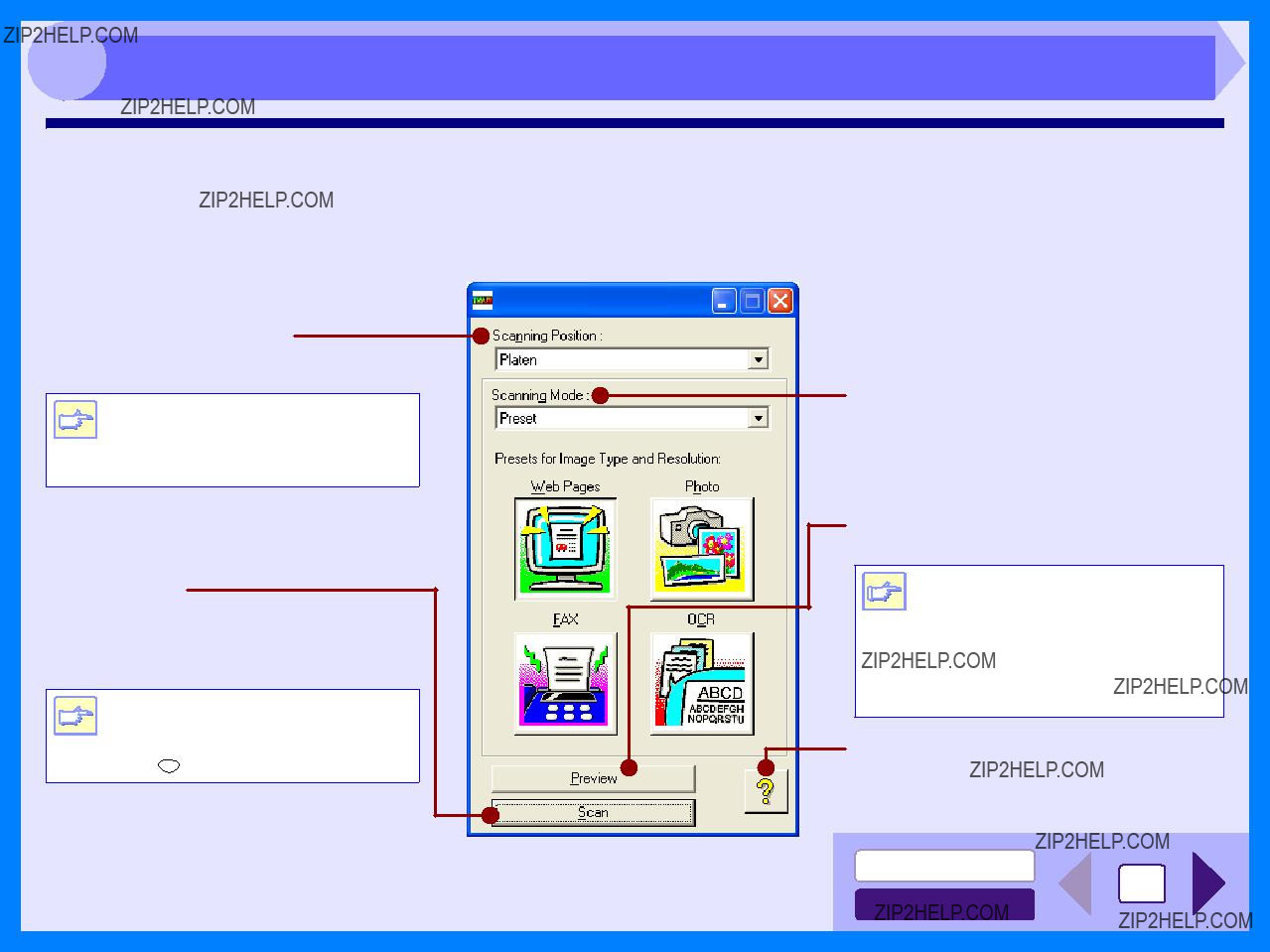
3 Scanning an Image from a
Scanner Driver Settings
The scanner driver setup screen consists of the
"Scanning Position" menu
Select the desired scanning position from "Platen" (original table) or "SPF".
Select "SPF" when you placed the


 original in the RSPF/SPF. On the unit Note without RSPF/SPF, this setting is
original in the RSPF/SPF. On the unit Note without RSPF/SPF, this setting is
fixed to "Platen".
"Scan" button
Click to scan an original or image according to your preferences. Before clicking the "Scan" button, check if your preferences are set correctly.
To cancel your scanning job after


 clicking the "Scan" button, press the Note [Esc] key on your keyboard or the
clicking the "Scan" button, press the Note [Esc] key on your keyboard or the
clear (  ) key on the unit.
) key on the unit.
"Scanning Mode" menu
Switch the scanning mode between the "Preset" and "Custom Settings" screen. For details on each of these settings, click the "Help" button to display Help.
"Preview" button
Previews the document.
If "Preview" is canceled by
immediately pressing the [Esc] key Note on your keyboard or the clear ( )
)
key on the unit, there may be no images displayed on the preview screen.
"Help" button
Click to display the help file for the scanner driver.

3 Scanning an Image from a
Preview screen
"Auto Scan Area Adjustment" button
Click when the preview screen is displayed to automatically set the scanning area.
Click the "Auto Scan Area Adjustment" button to adjust the scanning area automatically.
Entire preview screen
Preview window
Click the "Preview" button in the
"Brightness/Contrast" button
Click to change to the "Brightness/Contrast" screen and adjust the brightness and contrast settings for scanning.
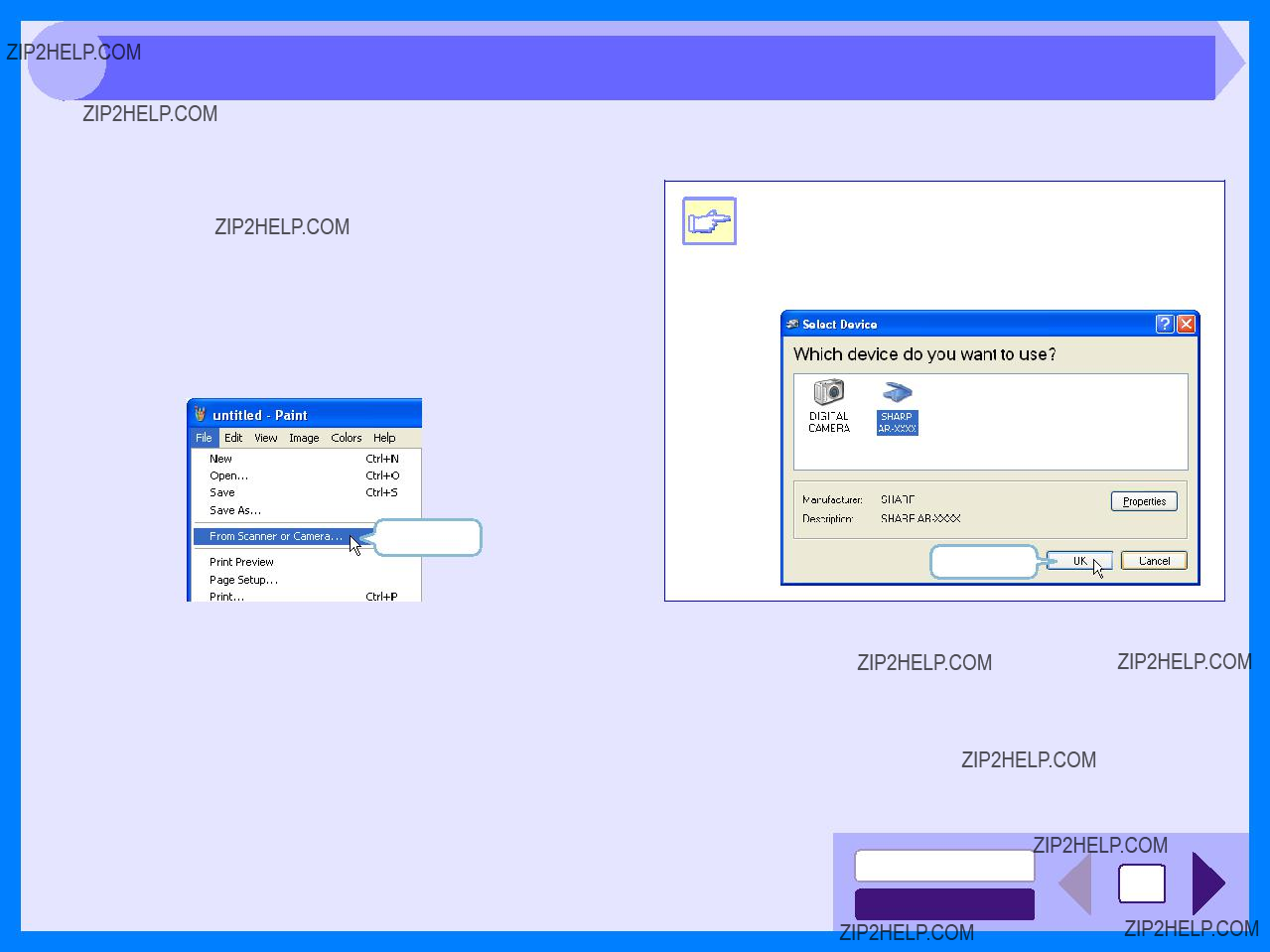
3 Scanning an Image from a
If you are using Windows XP, you can use the WIA driver to scan from Sharpdesk, Paint and other
Click here.
Click here.

3 Scanning an Image from a
!To view Help for a setting, click the ( ) button in the upper
) button in the upper
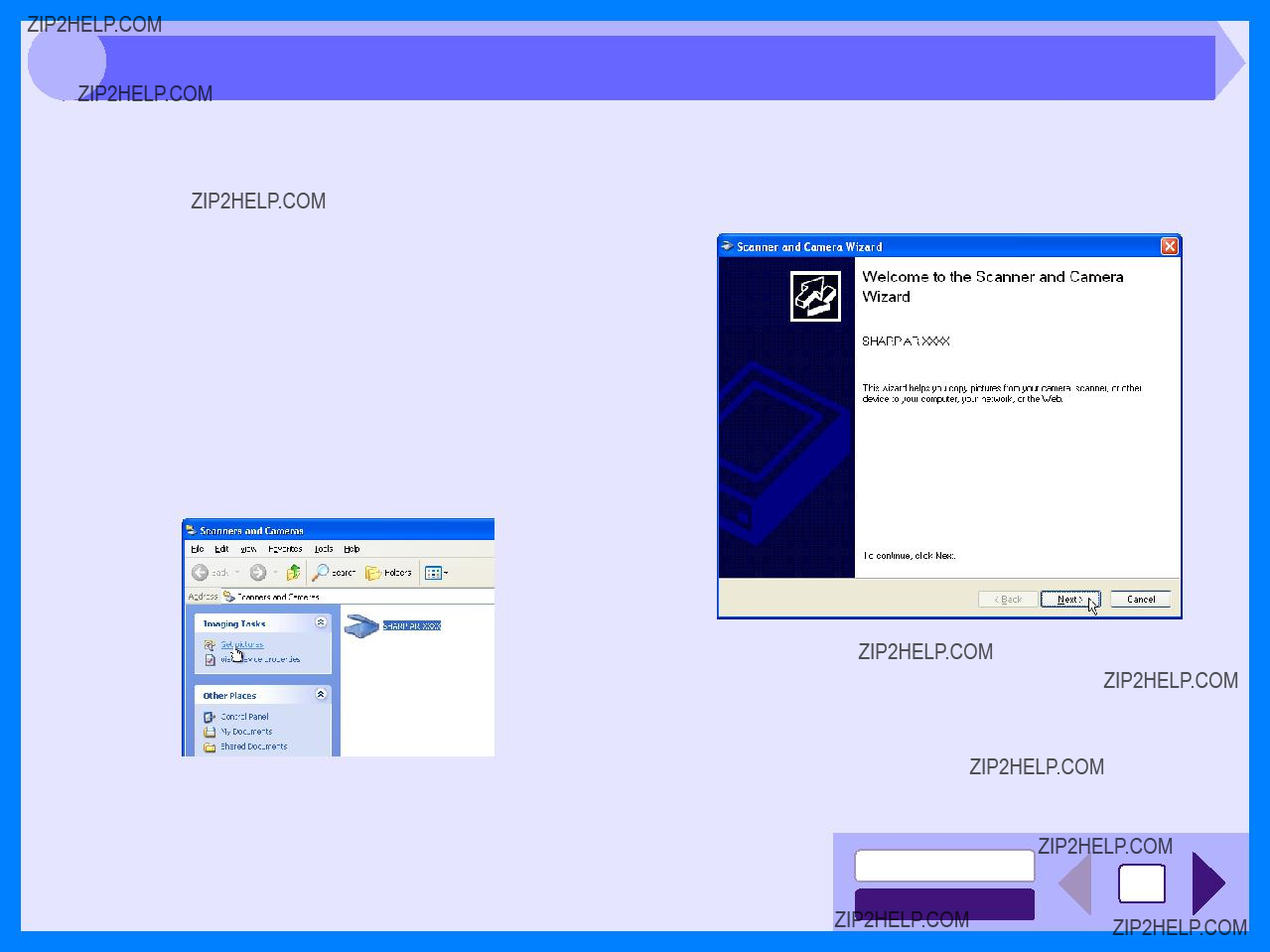
3 Scanning an Image from the "Scanner and Camera Wizard" (Windows XP) (part 1)
The procedure for scanning with the "Scanner and Camera Wizard" in Windows XP is explained here. The "Scanner and Camera Wizard" lets you scan an image without using a
pictures" in "Imaging Tasks".
The "Scanner and Camera Wizard" will appear.
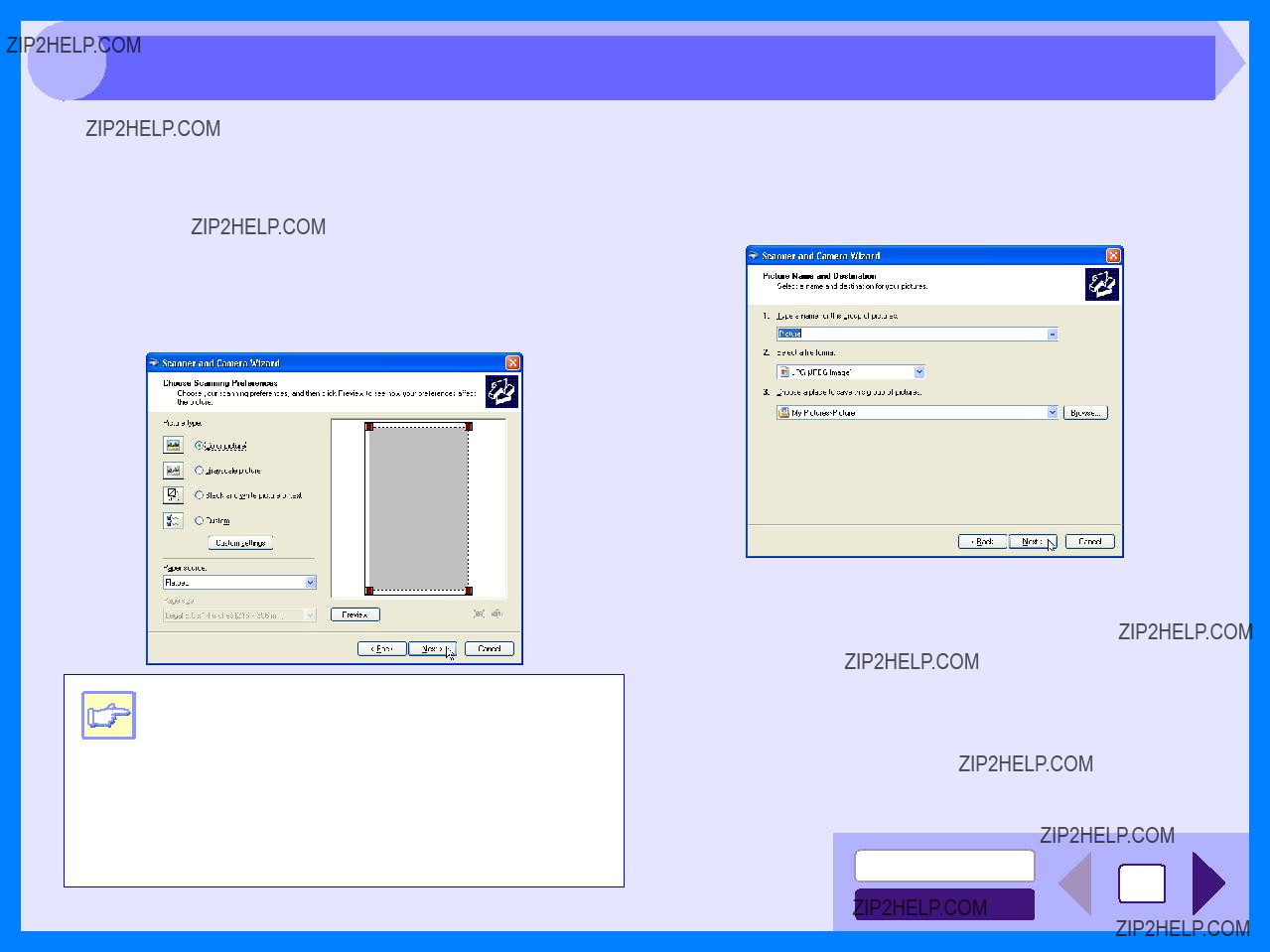
3 Scanning an Image from the "Scanner and Camera Wizard" (Windows XP) (part 2)
If you placed the original in the RSPF/SPF, select "Document Feeder" for the "Paper source" and specify the original size in "Page size".
You can click the "Preview" button to display the preview image.
!To adjust the resolution, picture type, brightness and contrast settings, click the "Custom settings" button.

3 Scanning an Image from the "Scanner and Camera Wizard" (Windows XP) (part 3)
If you are ready to end the session, click "Nothing. I'm finished working with these pictures".

3 Outline of Button Manager
Button Manager is a utility software to link scanning functions to the SCANNER key on the unit. This software enables you to set scanning functions to six different scan menus, which will be linked the SCANNER key on the unit.
Reference: To begin scanning using the unit's operation panel, settings must be established in the Control Panel after the Button Manager is installed. For information on installing the Button Manager, establishing the Control Panel settings, and scanning using the unit's operation panel, see "USING THE SCANNER MODE" in the Operation Manual.
The functions of Button Manager are shown below.
Tab
Click to set scan menu options.
"OK" button
Click to save your settings, and exit the dialog box.
"Cancel" button
Click this button to exit the dialog box without making any changes to the settings.
"Scan Setup" area
Set the scan conditions.
Some applications may limit your choice of settings.
Note
 "Application Selection" area
"Application Selection" area
Select the
"Help" button
Click this button to display the help file for Button Manager.
"Apply" button
Click to save your settings without closing the dialog box.
You can specify and change your six scan menu options from six functions. Refer to Button Manager Settings to specify and change the scan menu options.
Close the source application before using the SCANNER key on the unit.
Note
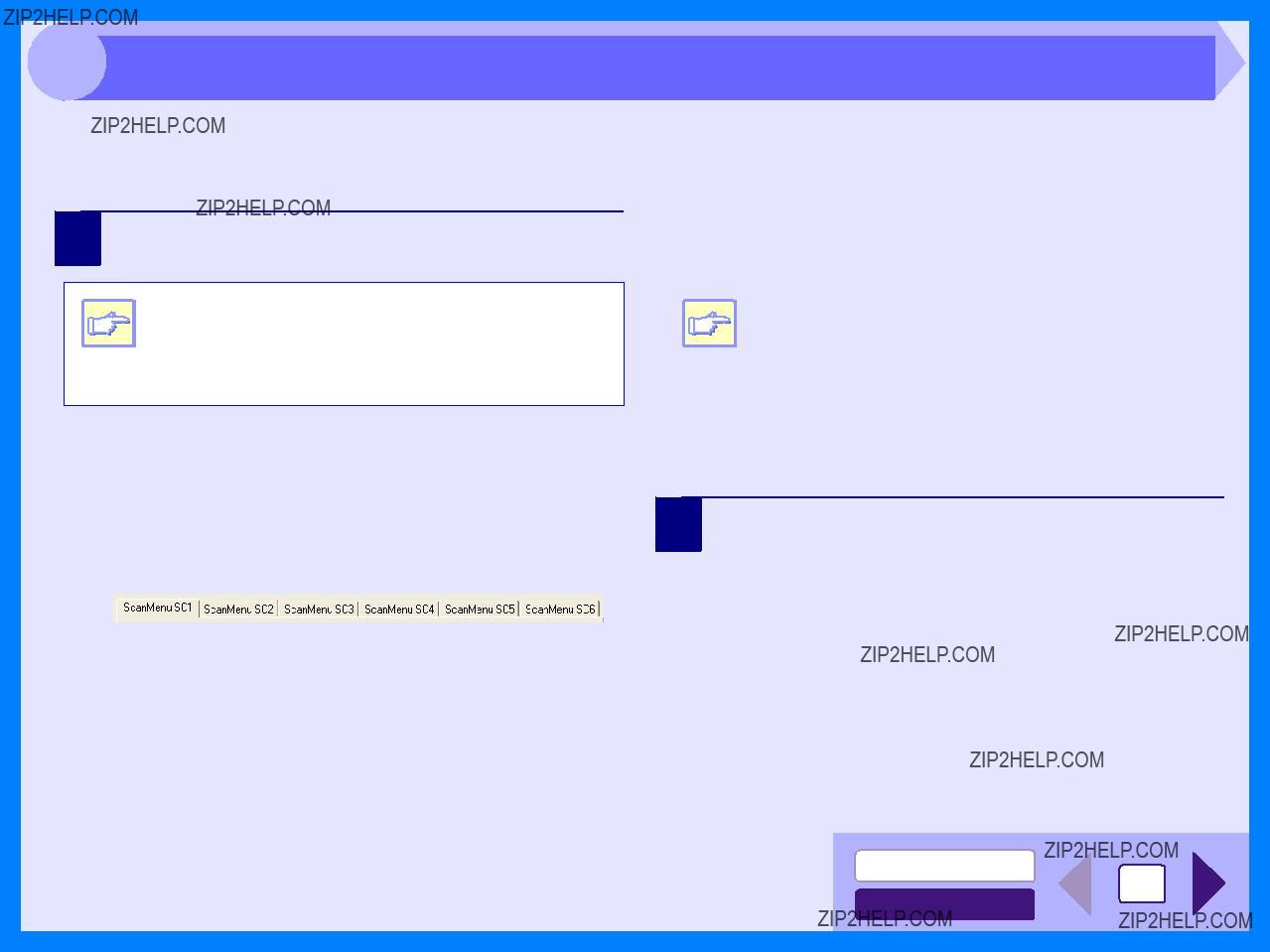
3 Button Manager Settings
After being installed, Button Manager normally keeps active under the Windows operating system. Follow the steps shown below to set scan options as you like.
For details on the settings in the setting screen of Button Manager, see Button Manager Help.
1 Rightbar.  ) on the task
) on the task
If the Button Manager icon does not appear on the task bar, click the "start" button, select "All
Programs" ("Programs" on Windows 98/Me/2000), Note select "SHARP Personal MFP series", and then
click "Button Manager" to start Button Manager.
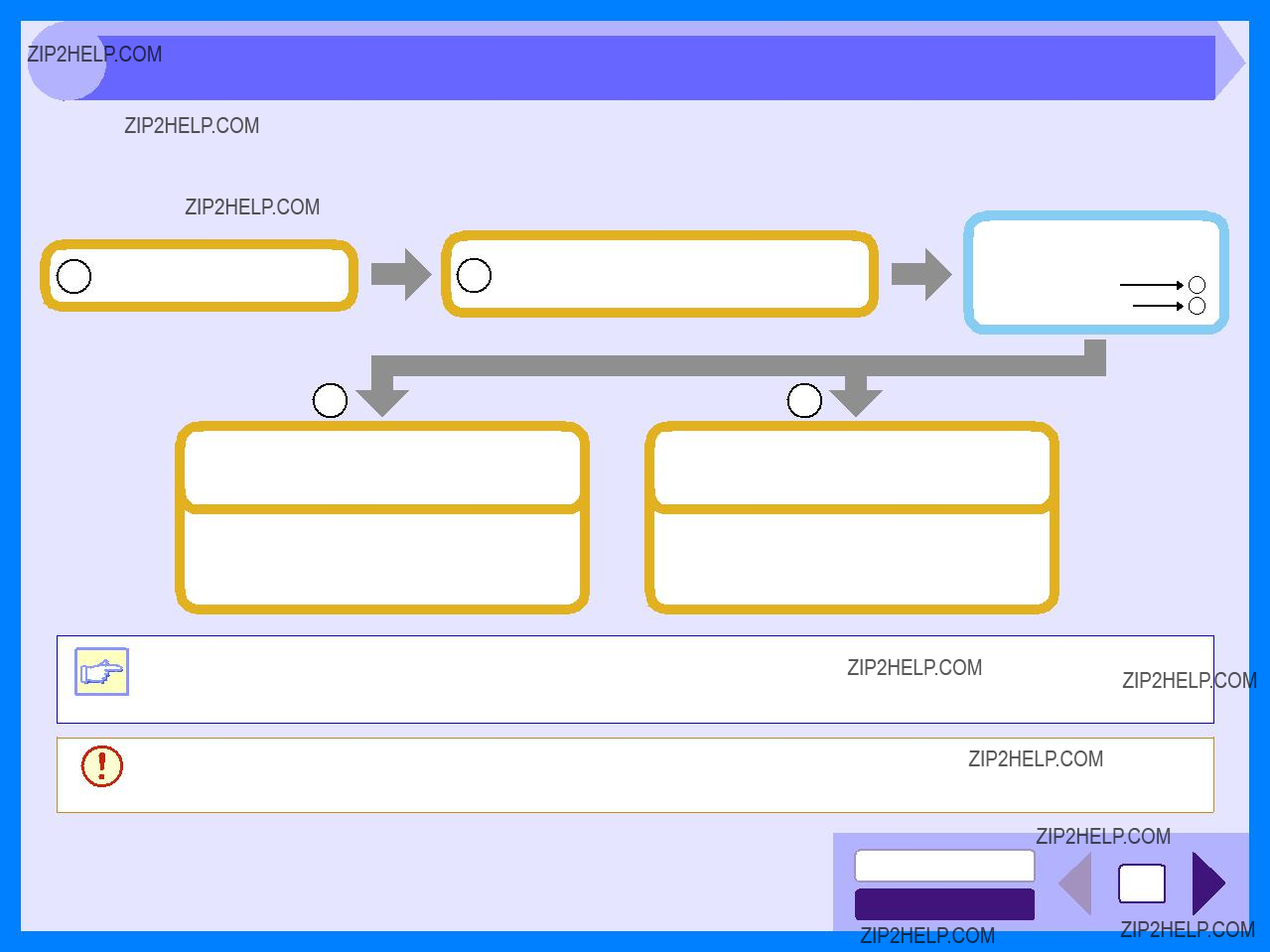
4 Identifying Unit Problems
When any trouble has occurred in the unit, first, verify whether you can make a copy or not with the unit. Check the items shown below when the unit does not work properly but it can make a copy.
Reference: If any copier trouble occurs, refer to "TROUBLESHOOTING" in the Operation Manual.
AB
What type of trouble do you have?
Printing trouble
When one of the troubles listed below occurs while printing, check the corresponding item.
Scanning trouble
When one of the troubles listed below occurs while scanning data, check the corresponding item.
The Scanned Image is Incorrectly Positioned Unable to Scan the Image
Make sure that the unit is not working. You cannot print from your computer or scan from the unit while the unit is making copies.
Note
The unit's scanning function can only be used if the unit is connected to your computer with a USB cable.
Caution
If you fail to solve the problem after verifying all the items listed above, please contact your authorized SHARP service center.

4 Check the Connection between the Unit and Computer
CHECK1 Is the interface cable compatible with the unit and computer?
Interface cables compatible with this unit are USB and parallel cables. Check which type of cable is supported by your computer, and then purchase one of the following cables accordingly:
USB cable
Shielded twisted pair cable (6 feet Max.:
Parallel interface cable
IEEE 1284 - Shielded type
The unit's scanning function can only be used if the unit is connected to your computer with a
Caution USB cable.
If the USB cable becomes disconnected
If the USB cable becomes disconnected, even only once during the unit's operation, then printing and scanning may be disrupted.
If this occurs, check the USB cable and ensure that it is securely connected, then restart the computer.
CHECK2 Is the interface cable connected securely?
Check if the interface cable is securely plugged into the connectors of the unit and computer. It is also advisable to ensure that the connector pins are not bent.
Reference: See "CONNECTING THE INTERFACE
CABLE" in the Operation Manual for more details on interface connection.
CHECK3 Are any other USB peripherals being connected along with the unit?
If other USB peripherals are connected through the same hub, disconnect them to see if the problem still exists.
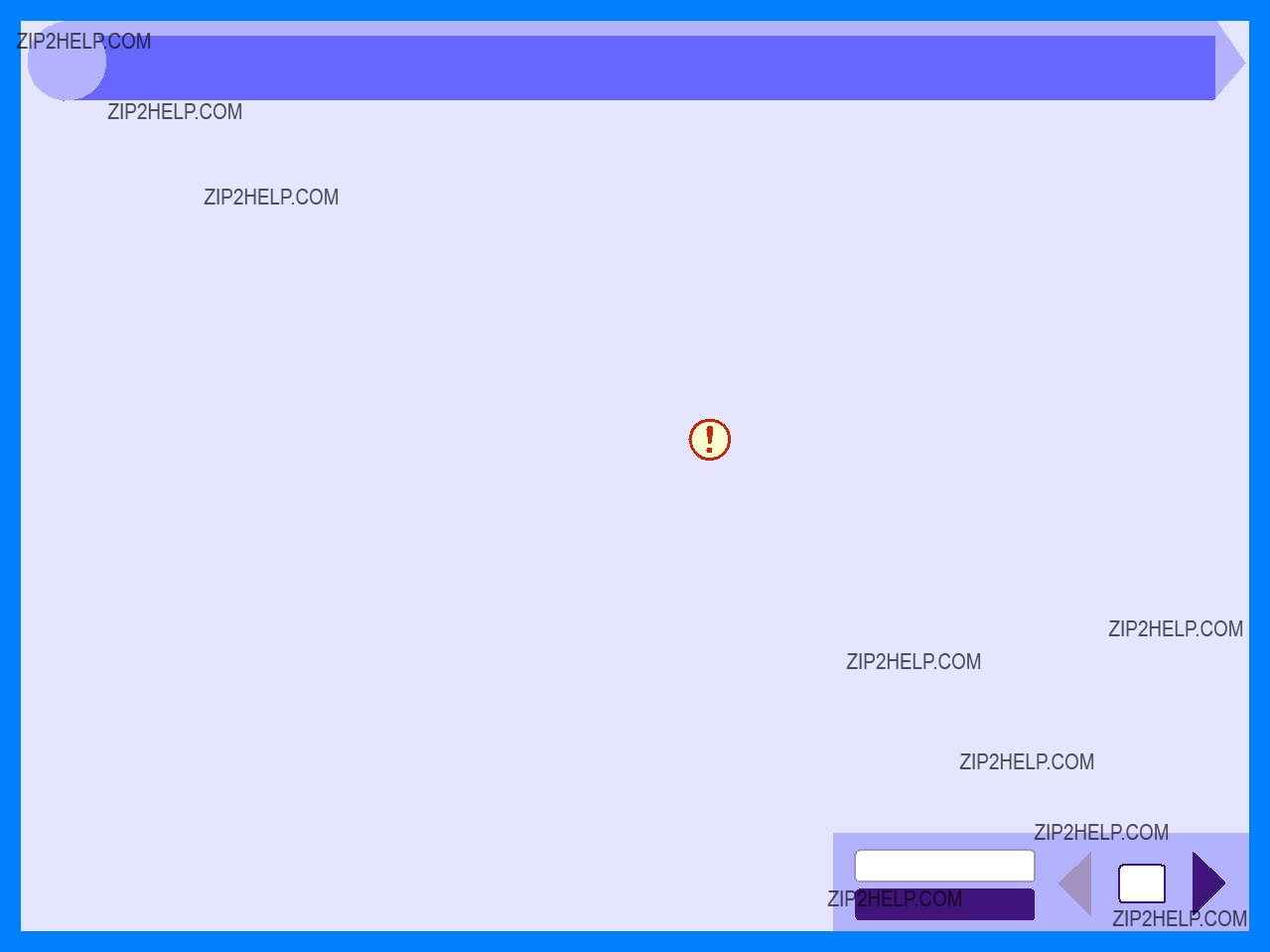
4 Check Your Computer
Reference: Plug and Play Screen does not Appear (when the USB is connected)
CHECK1 Is there enough computer memory or hard disk space?
To use this unit, you must have an adequate amount of hard disk space. If there is insufficient hard disk space, delete unnecessary files to increase the free space of the hard disk. If there is insufficient memory, close unnecessary applications to increase memory available for printing or scanning. If you are still unable to print or scan, install more memory into your computer.
CHECK2 Is your hard disk fragmented?
When data is frequently stored/deleted, the hard disk may become fragmented causing a reduction in printing or scanning speed. In this case it is recommended to defragment your hard disk. You may use the Windows tools or a commercially available hard disk defragmenting tool.
CHECK3 If your computer is connected to the unit through the parallel port, is the parallel port (LPT) mode set to other than EPP mode?
The unit may not operate correctly if the parallel port mode is set to EPP mode. To set the parallel port mode to a mode other than EPP mode, refer to your computer manual or ask the manufacturer of the computer. ECP mode is recommended to obtain the best performance from the unit. Note that some computers may use different names for the modes.

4 Plug and Play Screen does not Appear (when the USB is connected)
If the Plug and Play screen does not appear after you connect the unit to your computer with a USB cable and turn on the power of both devices, follow the steps below to verify that the USB port is available.
1
2
Click the "start" button, click "Control Panel", and then click "Performance and Maintenance".
On Windows 98/Me/2000, click the "Start" button, select "Settings", and then click "Control Panel".
Click "System", click the "Hardware" tab, and click the "Device Manager" button.
"Universal Serial Bus controllers" will appear in the list of devices.
SOFTWARE" in the Operation Manual.
!If the "System" icon does not appear on
Windows Me, click "view all Control Panel options" to view it.
Note !On Windows 98/Me,
!On Windows 2000,

4 Failed to Install the MFP Driver (Windows 2000/XP)
If the MFP driver cannot be installed under Windows 2000/XP, check your computer's settings according to the following procedure.
1
2
3
as explained in "INSTALLING THE SOFTWARE" in the Operation Manual.
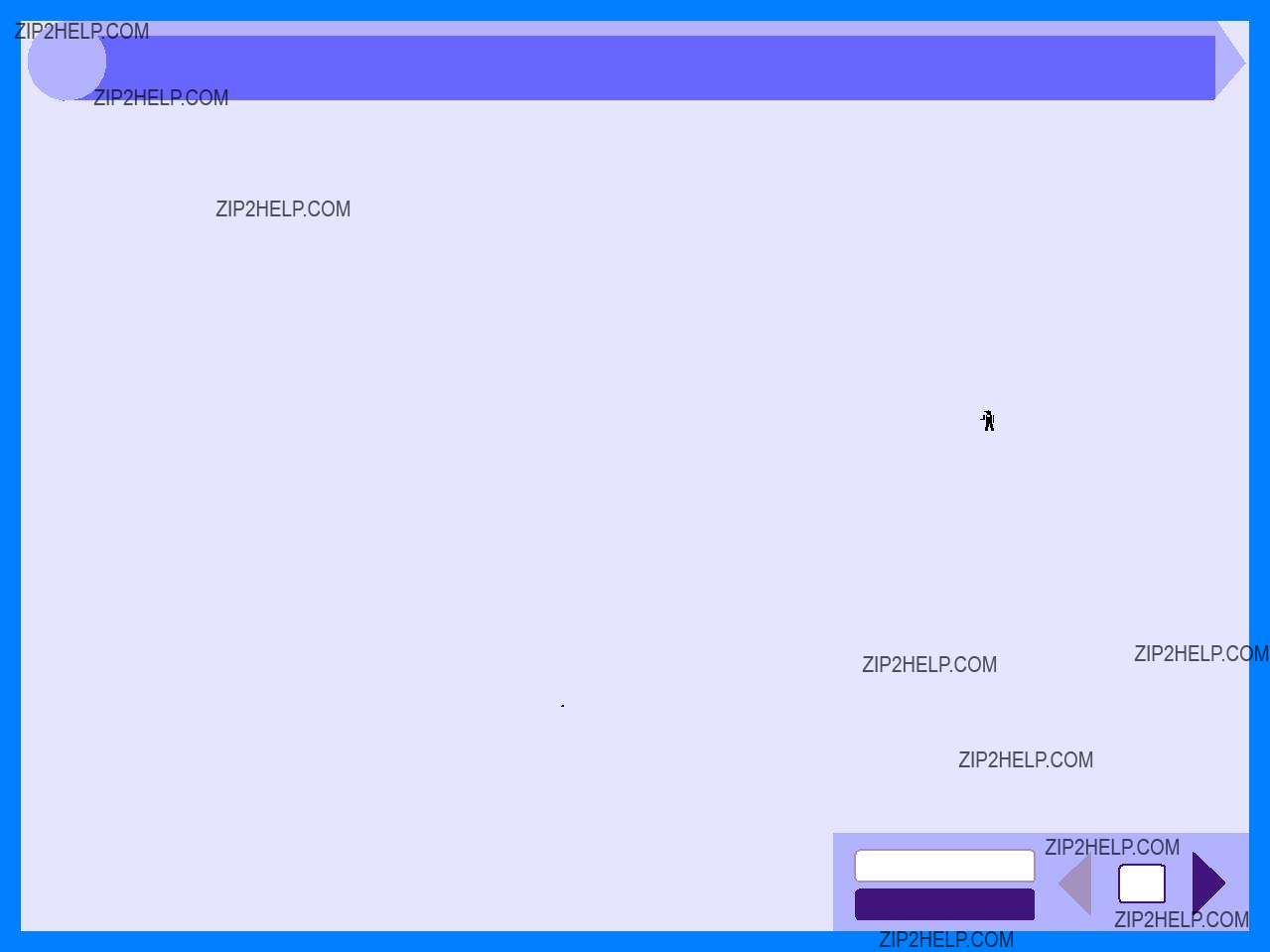
4 Faint, Uneven or Smeared Print Output
If print output is faint, uneven or smeared, follow the steps listed below.
CHECK1 Has the printer driver been specified to suit both paper and the print job?
You can select "Draft", "Normal" or "Photo" for the print quality in the "Advanced" tab of the printer driver setup screen. When "Photo" is selected, you can click the "Image Adjustment" button and adjust the brightness and contrast in the dialog box that appears. Adjust these settings appropriately for your print data and try printing again.
Reference: Printer Driver Settings
CHECK2 Is the paper curled?
If the paper is curled, straighten it up and set it in the unit again.
CHECK3 Is the paper too thick or too thin?
Only paper weighing from 15 lbs. To 21 lbs. can be used in the paper tray. Only paper weighing from 14 lbs. To 34.5 lbs. can be used in the
CHECK4 Is the developer replacement required indicator lit?
When the developer replacement required (

 ) indicator lights up, the developer should be replaced. DEVELOPER REPLACEMENT SHOULD
) indicator lights up, the developer should be replaced. DEVELOPER REPLACEMENT SHOULD
ONLY BE DONE BY AN AUTHORIZED SHARP SERVICE TECHNICIAN. Contact your service center as soon as possible.
CHECK5 Is it near time to replace the toner cartridge?
When it is near time to replace the toner cartridge, the toner cartridge replacement required ( ) indicator will light up on the unit operation panel. When it is time to replace the cartridge, the indicator will blink. Replace the cartridge and try printing again.
) indicator will light up on the unit operation panel. When it is time to replace the cartridge, the indicator will blink. Replace the cartridge and try printing again.
Reference: See "TONER CARTRIDGE REPLACEMENT"
in the Operation Manual.
CHECK6 Is the maintenance indicator lit?
When the maintenance ( ) indicator lights up, service by an authorized SHARP service technician is required. Contact your service center as soon as possible.
CHECK7 Did you set sufficient margins in the paper settings of your application?
If the margins are set outside of the quality guaranteed area, smudges or smears may appear at the upper and lower edges of the paper.
When selecting the paper settings in the application, set the margins from the top, bottom, left and right edges of the paper to 5/32".

4 Characters or Graphics are not Printed in Correct Position
If a document is printed skewed or partly off the paper, follow the steps listed below.
CHECK1 Is the paper size loaded in the tray the same as that specified in the printer driver?
Check if the "Paper Size" options suit the size of the paper loaded in the tray.
If the "Fit To Page" setting is activated, make sure that the paper size selected from the
CHECK2 Is the orientation of document setting correct?
Click the "Paper" tab in the printer driver setup screen, and verify if the "Image Orientation" option is set to your requirements.
CHECK3 Is the paper loaded correctly?
If a document is physically damaged when it is output or the image is skewed on the paper, discard the damaged sheet, reinsert the paper supply and print again. Insert the paper so that there is no visible space between the paper and the paper guides.
Reference: See "LOADING PAPER" in the Operation
Manual for more details on inserting paper.
CHECK4 Did you correctly specify the margins for the application in use?
Check the layout of the document margins and the paper size settings for the application you are using. Also check if the print settings are specified correctly to suit the paper size.
Reference: Faint, Uneven or Smeared Print Output

4 Nothing Prints
If nothing prints even when the unit is turned on, please wait a few moments. The unit needs a longer time to process intricate data. If the unit still does not print, refer to the check list below.
CHECK1 Has a paper jam occurred?
When the misfeed ( ) indicator blinks or (
) indicator blinks or (  ) blinks in the display, the unit will stop because of a misfeed.
) blinks in the display, the unit will stop because of a misfeed.
Remove the jammed paper as explained in "MISFEED REMOVAL" in the Operation Manual.
CHECK2 Is the ONLINE indicator off?
The ONLINE indicator on the operation panel turns off while the unit is used for copying. Printing is not possible at this time. When copying is finished, the ONLINE indicator will turn on after the set auto clear time elapses, and the unit will be ready for printing. You can also press the clear ( ) key twice or press the ONLINE key to make the unit ready for printing.
) key twice or press the ONLINE key to make the unit ready for printing.
CHECK3 Is your unit selected correctly in the current application for the print job?
When choosing "Print" from the "File" menu located in applications, be sure you have selected "SHARP AR- XXXX" (where XXXX is the model name of your unit) printer displayed in the "Print" dialog box.
Check here.
CHECK4 Has the printer driver been installed properly?
Check if the printer driver has been installed, following the steps listed below.
1Click the "start" button, click "Control Panel", click "Printers and Other Hardware", and then click "Printers and Faxes".
On Windows 95/98/Me/NT 4.0/2000, click the "Start" button, select "Settings" and then click "Printers".
2Check if the "SHARP
If you still cannot print after confirming the "SHARP AR- XXXX" (where XXXX is the model name of your unit) printer driver icon, the printer driver may not have been installed correctly. In this case, delete SHARP Personal MFP series software and then reinstall it.
Reference: Uninstalling SHARP Personal MFP Series Software
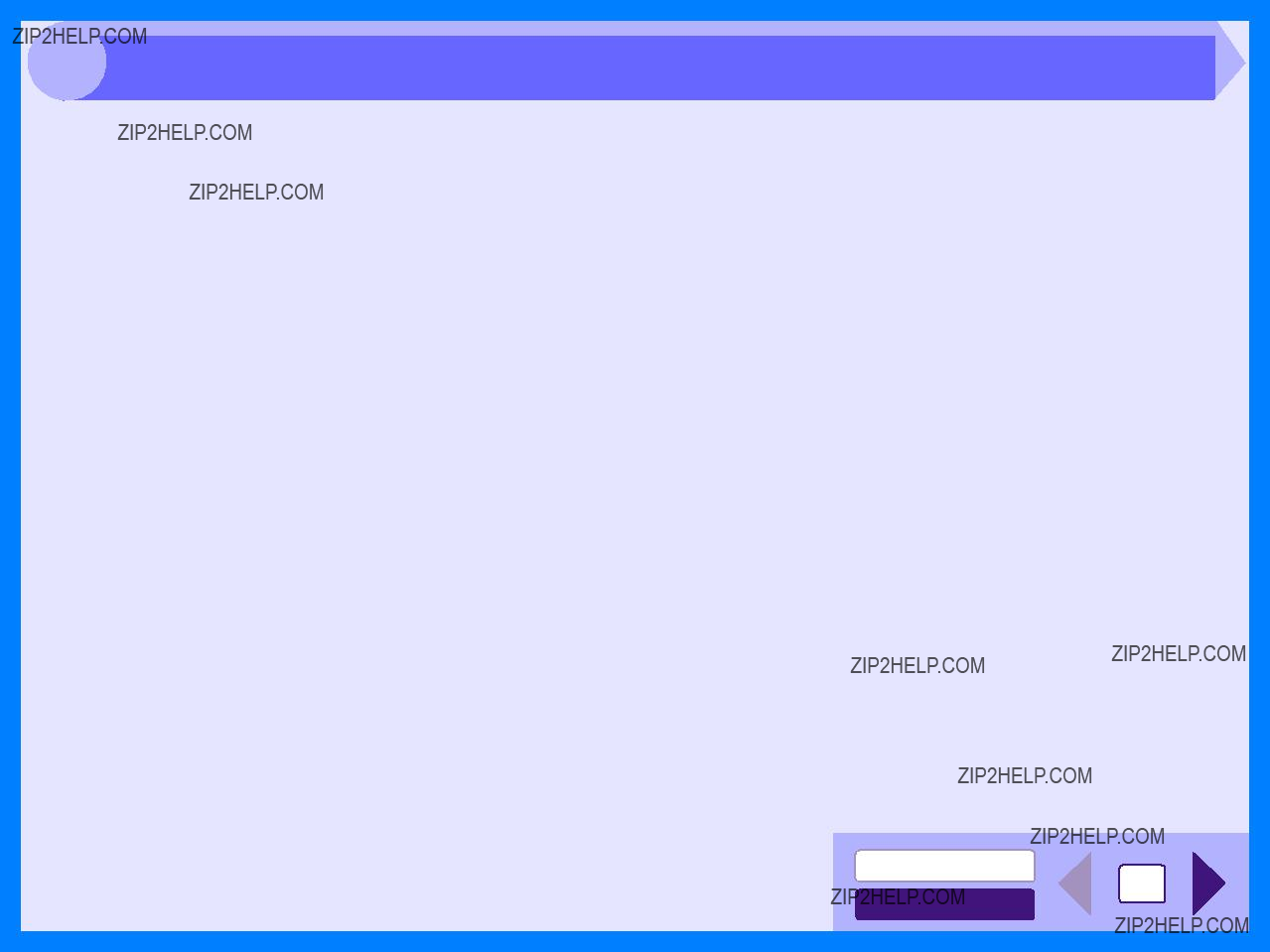
4 Poor Scanning Result
If you get poor quality as a result of a scanning job, and you cannot improve the quality by changing preferences, refer to the check list shown below.
CHECK1 Is the original clean?
Check your original before scanning. If any dust sticks to the original, you cannot obtain a clean result. In addition, make sure that the original table is also clean.
CHECK2 Have you specified a suitable resolution?
Make sure that the value for the "Resolution" setting in the scanner driver satisfies the requirement of the set original.
Reference: Scanning an Image from a TWAIN-
Scanning an Image from a
Scanning an Image from the "Scanner and
CHECK3 Have you specified a suitable value for the "B/ W Threshold" setting?
If you are scanning with a
Reference: Scanning an Image from a TWAIN-
CHECK4 Have you adjusted the brightness and contrast suitably?
If you are scanning with a
If you are scanning with a
If part of the image from the back side of the original appears in the preview scan.
If you are using a
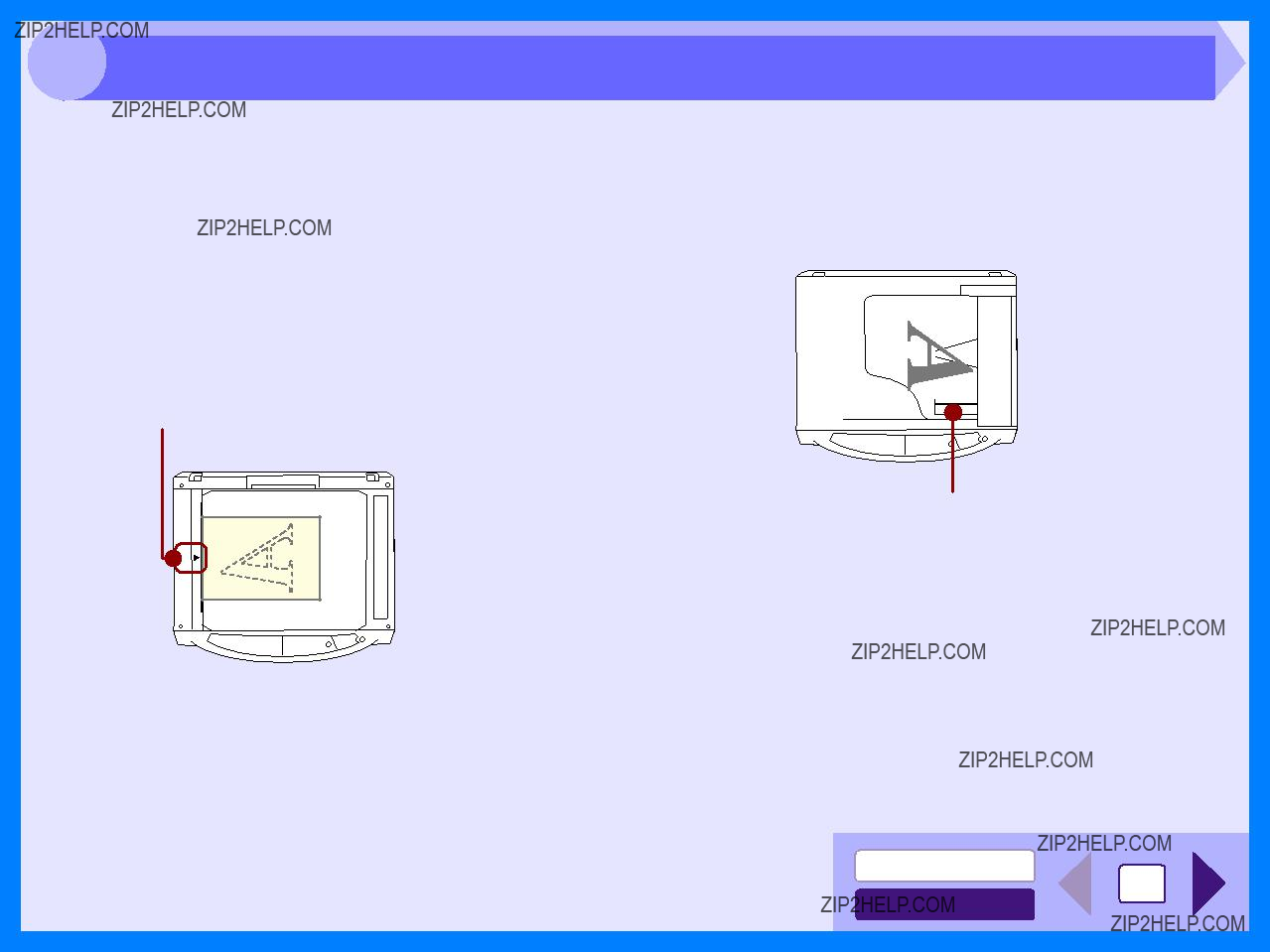
4 The Scanned Image is Incorrectly Positioned
If the scanned image is incorrectly positioned, refer to the check list shown below.
Align the center of the original with ( ) mark.
) mark.
Align the guide to the original.

4 Unable to Scan the Image
If you cannot scan the image, turn off your computer. Press the power switch on the unit to turn it off, unplug the unit from the power source, and then plug it back in. Restart your computer. Try scanning again. If scanning is still not possible, refer to the check list below.
CHECK3 Have you specified all scanning preferences appropriately?
Setting a large area with full color together with a high resolution setting, makes the data size large, resulting in extended scanning times. It is recommended to set the scanning preferences depending on the type of original to be scanned, i.e., Text, Text/Graphics, Photograph, Color, Black & White.
CHECK4 Is there enough computer memory?
Your computer may not have enough available memory to hold the document you want to scan. Lower the scan resolution.
CHECK5 Has the specified period of program timeout already elapsed?
Neither printing nor scanning jobs can be sent to the unit from your computer during the specified period of program timeout after copying.
To send a scanning job immediately, press the clear
( ) key twice, ONLINE key or SCANNER key on the unit.
) key twice, ONLINE key or SCANNER key on the unit.
Reference: For more detail, refer to "USER
PROGRAMS" in the Operation Manual.
CHECK8 Are you using an appropriate interface?
Only the USB interface can be used for the unit's scanning function. Make sure the unit is connected to your computer with a USB cable. If the unit was connected to your computer with a parallel cable when you installed the
SHARP Personal MFP series software, uninstall the SHARP Personal MFP series software. Refer to
"INSTALLING THE SOFTWARE" in the Operation Manual for the order of installation of the SHARP Personal MFP series software and connection of the USB cable, and reinstall the SHARP Personal MFP series software.
Reference: Uninstalling SHARP Personal MFP Series Software
CHECK9 Have the scanner driver and Button Manager been installed properly?
If normal scanning still cannot be performed even after confirming the items on the above check list, delete SHARP Personal MFP series software and then reinstall it.
Reference: Uninstalling SHARP Personal MFP Series Software

4 Uninstalling SHARP Personal MFP Series Software
If printing or scanning is not possible, or Button Manager does not function correctly, check the items in "Nothing Prints" or "Unable to Scan the Image". If you still cannot solve the problem, follow the steps below to uninstall SHARP Personal MFP series software (MFP driver (printer driver/scanner driver), Button Manager), and then reinstall it.
Before uninstalling SHARP Personal MFP series software, close all applications.
Caution
1
2
Click "Add or Remove Programs".
On Windows 95/98/Me/NT 4.0/2000,
The following dialog box will open.
Delete the "SHARP MFP driver" and the "Button Manager (SHARP Personal MFP series)" from the list of applications. For more information, refer to your operating manual or to the help files for your operating system.

5 Index
T
U
W